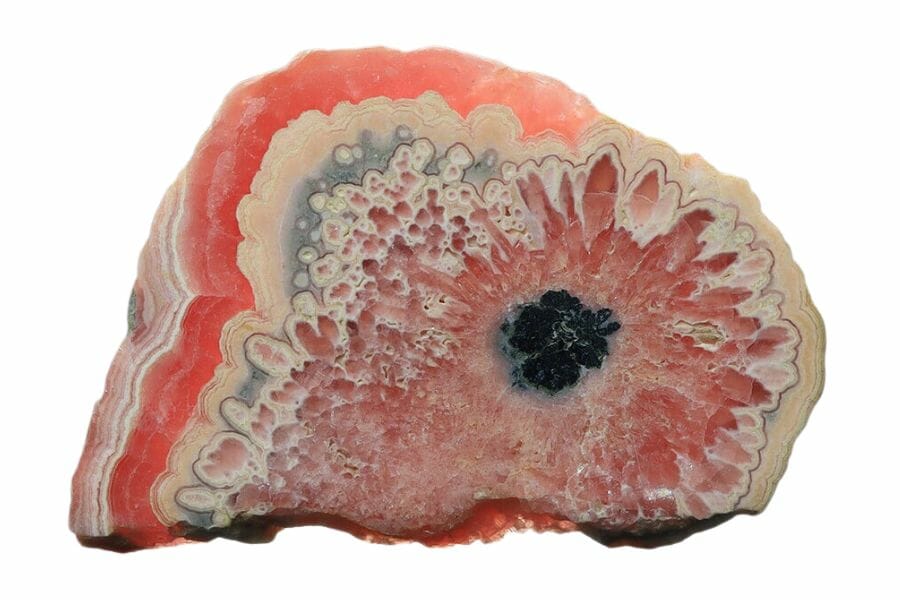Massachusetts may not be as vast as some of our western states, but it boasts a treasure trove of geological wonders all its own. Every nook and cranny of this state hides a story written in stone.
The beautiful rocks and minerals found in Massachusetts deserve the limelight too. For example, the state is home to a variety of garnets, some of which are transparent and perfect for gem-quality jewelry.
Plus, the state’s rolling hills and deep valleys are packed with beryl, garnet, and even rhodonite, and more!
What’s more, the long history of Massachusetts has seen it change and evolve over millions of years, resulting in the rich geological tapestry we see today.
The landscapes tell tales of ancient seas, mighty glaciers, and volcanic eruptions, all of which have left their mark with a colorful assortment of rocks and minerals.
So, if you’ve got a thirst for geological adventures, Massachusetts should be on your bucket list. Ready to embark on a journey into its stony heart? Let’s uncover the secrets beneath our feet!
A List of The Common Rocks, Stones, and Minerals Found in Massachusetts
From sparkling gems to fascinating rocks and minerals, Massachusetts boasts a variety of geological wonders. You can check out our comprehensive guides to learn more about what the state has to offer:
The Massachusetts State Rock, Mineral, and Gem
Before we get into the specifics, it helps to know what the official state options are:
| Massachusetts State Rock | Roxbury puddingstone |
| Massachusetts State Mineral | Babingtonite |
| Massachusetts State Gem | Rhodonite |
Rockhounding in Massachusetts is like a thrilling treasure hunt! Make sure to check out the Massachusetts Department of Environmental Protection (MASSDEP) website before you go exploring.
Jasper
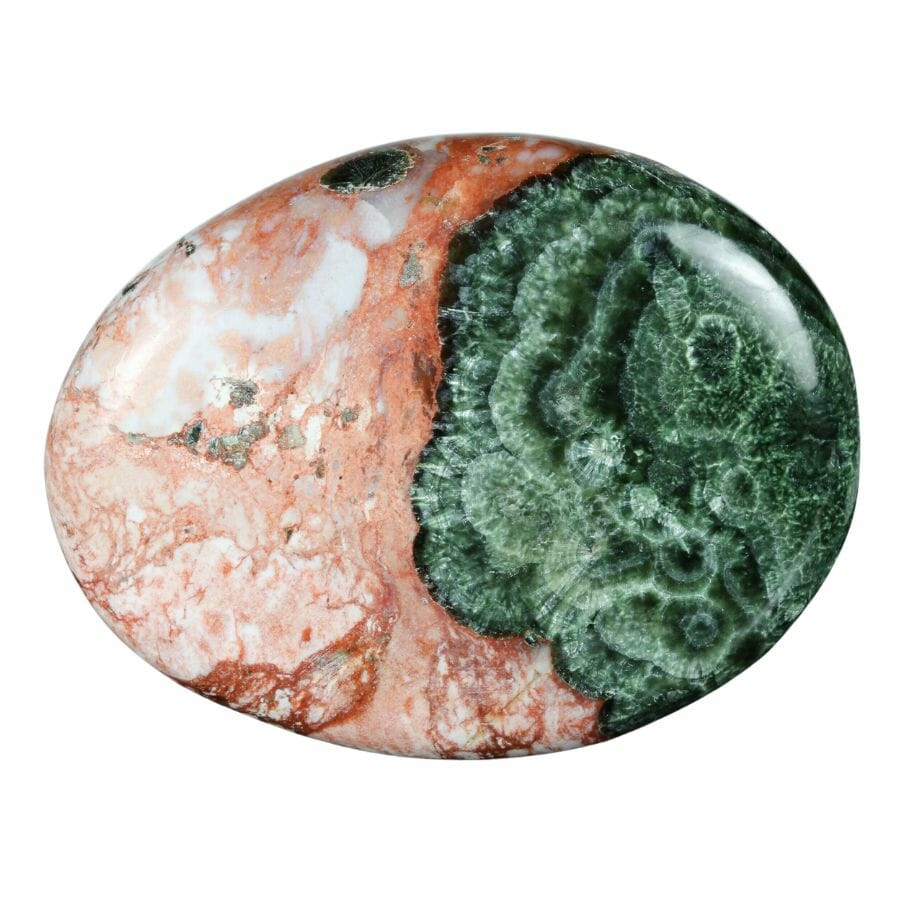
Jasper is a fascinating rock that you can find right here in Massachusetts. It comes with a splash of colors and patterns all mixed together. Jasper is actually a type of quartz, but it’s way more colorful and interesting than regular quartz.
It all starts deep underground with flowing hot water. This hot water carries tiny bits of minerals like iron, which mix with silica. As the water cools down, these minerals start to stick together. Eventually, they turn into jasper.
It’s like a slow and careful recipe that takes millions of years to cook! The different colors and patterns in jasper come from the various minerals that get mixed in.
People have loved and valued jasper for thousands of years. Not just because it’s pretty, but also because it’s tough and can be carved into all sorts of things like bowls, jewelry, and statues.
Some folks even believe that jasper has special powers, like bringing good luck or calming your nerves. Whether or not you believe in that, there’s no denying that jasper is a real gem of a rock.
Where you can find jasper in Massachusetts
- Hoosac River “Jasper” locality, Williamstown
- Allston-Brighton, Boston
- Saugus, Essex County
Beryl
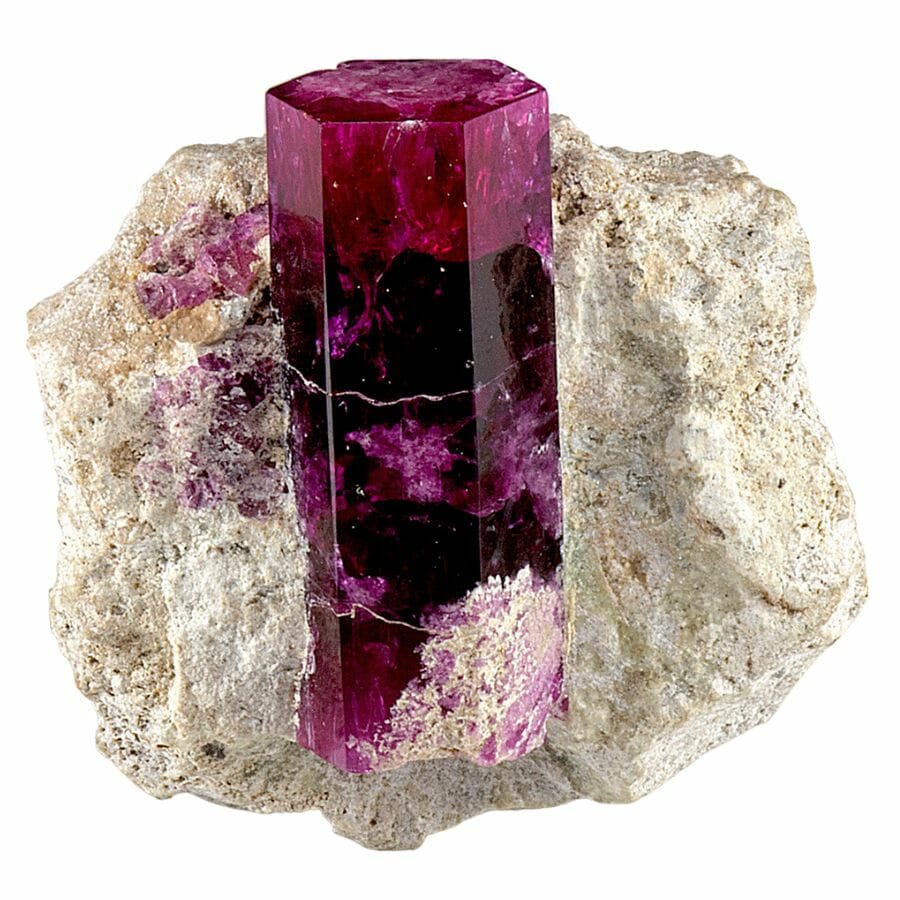
Beryl is one of the coolest gemstones found in Massachusetts! It comes in a variety of colors, and each gem color gets its own special name. For example, when beryl is green, we call it emerald. When it’s pale blue, it goes by the name aquamarine.
Deep beneath the Earth’s surface, hot magma is constantly moving. As this magma cools, various minerals start to form. Beryl is born when certain elements, like beryllium, mix with other elements in just the right way.
Over a lot of time, and with a dash of geological luck, these elements come together to create the dazzling crystals we know as beryl.
Beryl is beautiful to look at, whatever color it comes in. But there’s more to it than just looks. Beryl is also hard and durable, which means it doesn’t scratch easily. This makes it perfect for things like rings or necklaces that get worn every day.
Where you can find beryl in Massachusetts
- Route 146 road cut, Sutton
- Acton, Middlesex County
- Route 114 pegmatite locality, North Andover
Galena
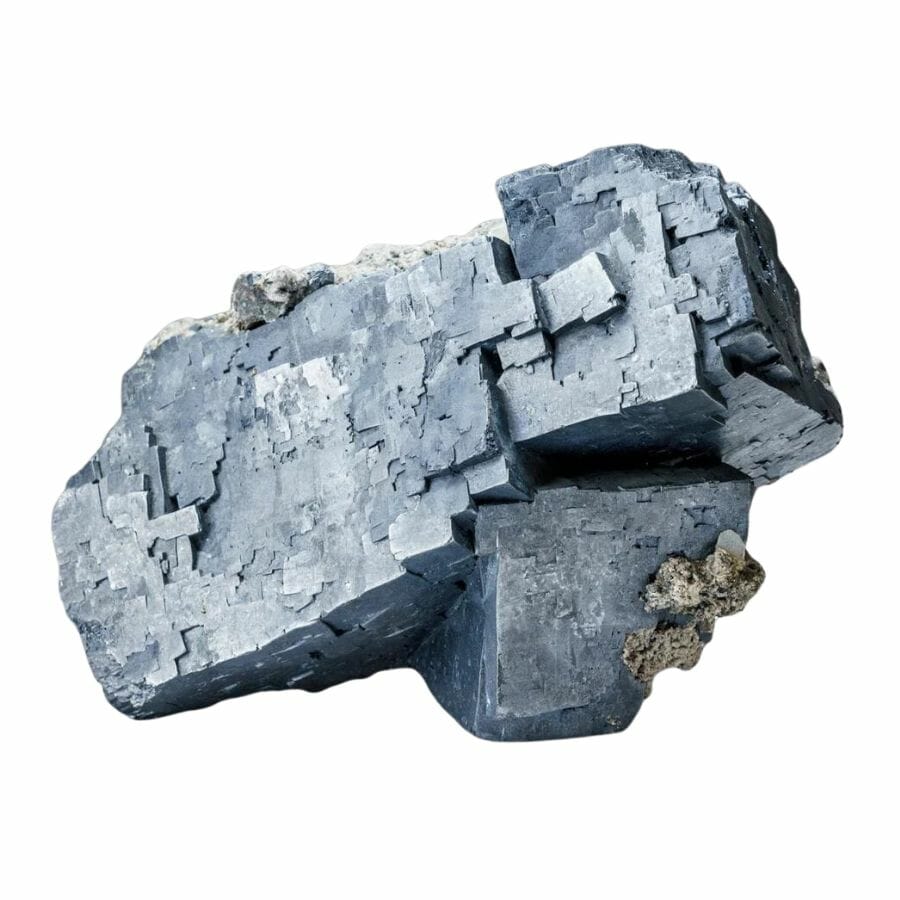
Galena is one of those minerals that might not win a beauty contest against sparkly gems, but it has its own special charm and value. It’s often recognized by its metallic gray color and cube-like shapes.
This mineral likes to hang out in places where there’s magma. When magma starts to cool down, different minerals form. Sometimes, one of those minerals is galena.
Galena is actually super important in our daily lives! It’s the main ore of lead, which we use in things like car batteries and shielding for medical X-rays. So, galena might not make beautiful jewelry, but it’s a real workhorse in our modern world.
In Massachusetts, galena is a part of the geological puzzle. It tells us about the ancient conditions deep within the Earth, and how those have shaped the land over millions of years.
Galena may not be the flashiest mineral, but it’s a solid and valuable part of Massachusetts’ rocky landscape!
Where you can find galena in Massachusetts
- Newburyport area lead mines, Essex County
- Montgomery area mines, Hampden County
- Devil’s Basin Quarry, Essex County
Chalcopyrite
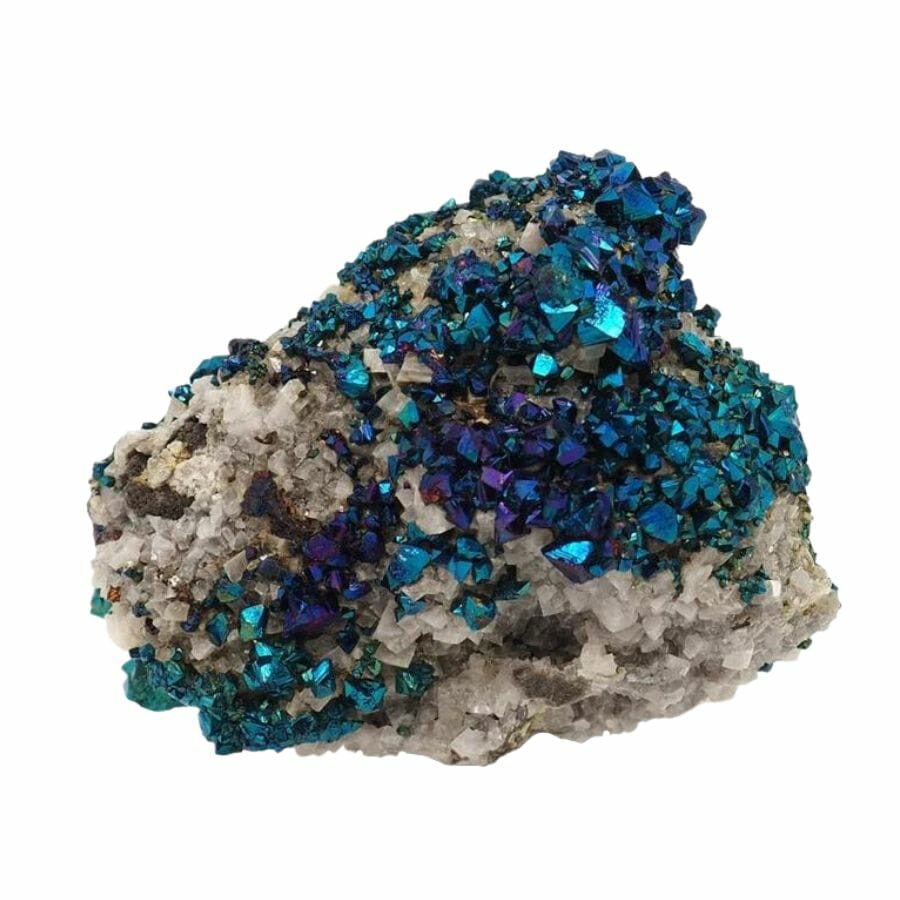
When you look at chalcopyrite, you might think you’ve struck gold. It’s one of the most fascinating types of rocks found in Massachusetts, and that’s saying a lot!
It can come in this amazing golden-yellow color with an eye-catching metallic luster. But hold on, it’s not gold – it’s a mineral made mostly of copper, iron, and sulfur!
Sometimes, it can also come in blues, purples, and pinks.
Imagine deep underground, where rocks are constantly shifting and changing. In these hidden places, hot fluids filled with all sorts of elements move through the cracks.
When these fluids cool down, the elements come together and form minerals like chalcopyrite.
Beyond its glittering exterior, it’s super handy. This mineral is a major source of copper, an element we use in loads of ways, from making coins to crafting electrical wires.
Thanks to chalcopyrite, we have access to the copper that’s become essential in our daily lives.
Where you can find chalcopyrite in Massachusetts
- Davis Mine, Rowe
- Devil’s Basin Quarry, Essex County
- West Springfield area mines, Hampshire County
Apatite
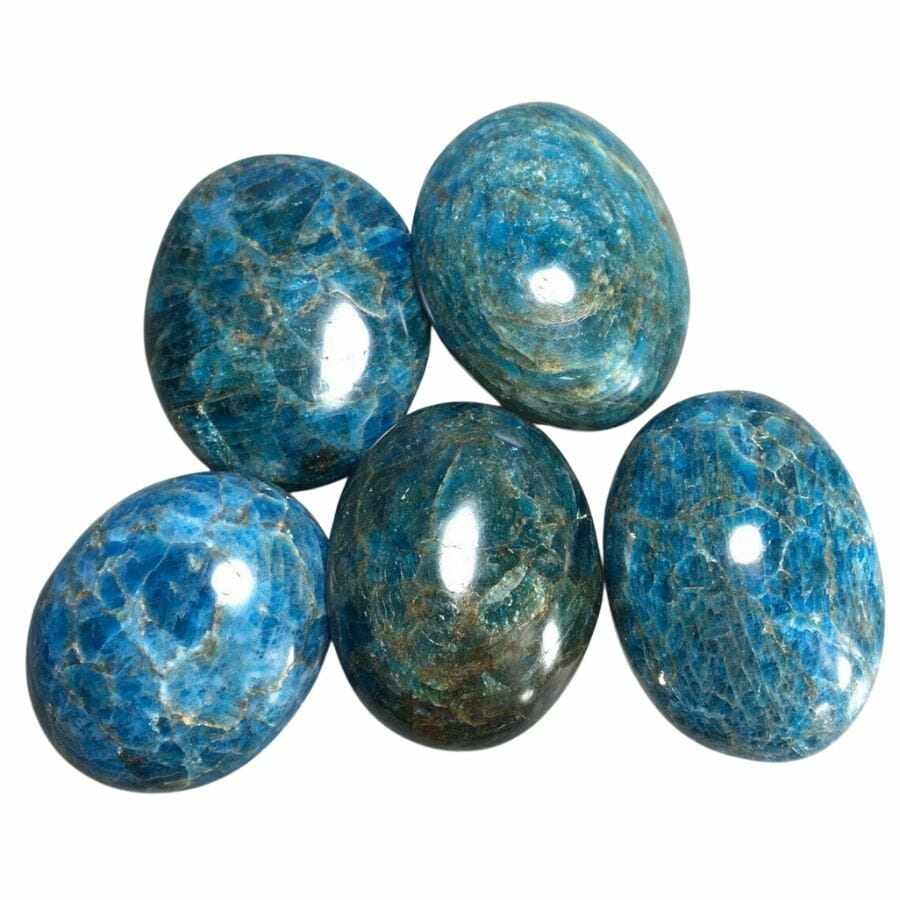
Apatite might not be as famous as diamonds or gold, but it has a charm of its own. This cool mineral comes in a rainbow of colors – from dreamy blues and vibrant greens to subtle yellows and clear crystals.
Apatite’s journey begins deep inside our planet. Earth’s underground world is a hot and bustling place, with liquids full of different elements. As these liquids start to cool, the elements inside begin to team up.
When phosphorus, calcium, and a few other elements decide to join forces, they create the wonderful mineral known as apatite.
Because apatite is a stunning gem, it’s a favorite for some jewelry pieces. But that’s not all apatite can do.
This mineral is also a key player in the world of farming because it’s the main source of phosphorus.
Phosphorus is a key ingredient in fertilizers that help plants grow strong and healthy. Without apatite, our gardens and farms might not be as green and lush!
Where you can find apatite in Massachusetts
- Barrus Farm, Goshen
- Lime Quarry Reservation, Chelmsford
Almandine
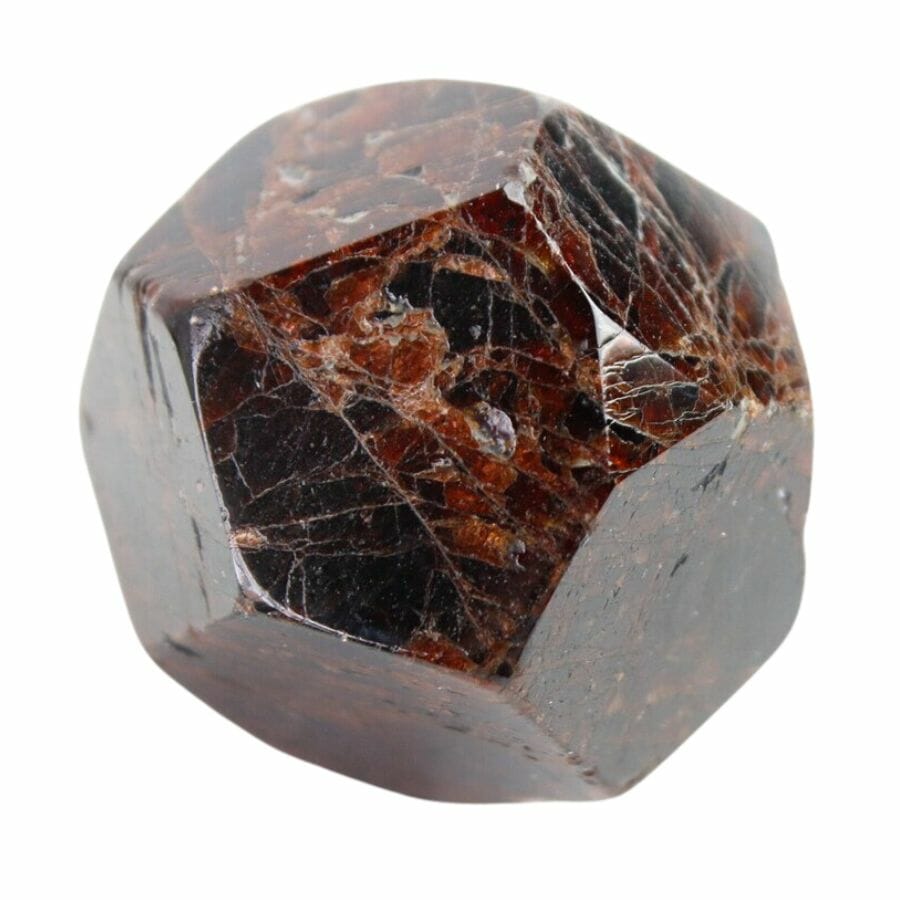
Almandine is one of the types of garnet, and it’s well-known for its deep, red hue that can sometimes have a hint of orange or violet. Imagine the glow of a sunset captured inside a stone. That’s almandine for you!
The formation of almandine all starts deep inside the Earth, where everything’s warm and pressures are super high. Here, in these depths, rocks undergo transformations.
When specific elements like iron, aluminum, and silica decide to come together under these intense conditions, they give birth to almandine.
Almandine’s gorgeous color makes it a favorite in jewelry. People have been turning almandine into sparkling gems for rings, necklaces, and other accessories for ages.
It has also been used in industrial settings. Its hardness makes it great for things like sandpaper, where it can grind and polish other materials.
Where you can find almandine in Massachusetts
- Marlborough Junction locality, Marlborough
- Rollstone Hill Quarries, Fitchburg
- Walnut Hill Pegmatite prospect, Huntington (Norwich)
Fluorapatite
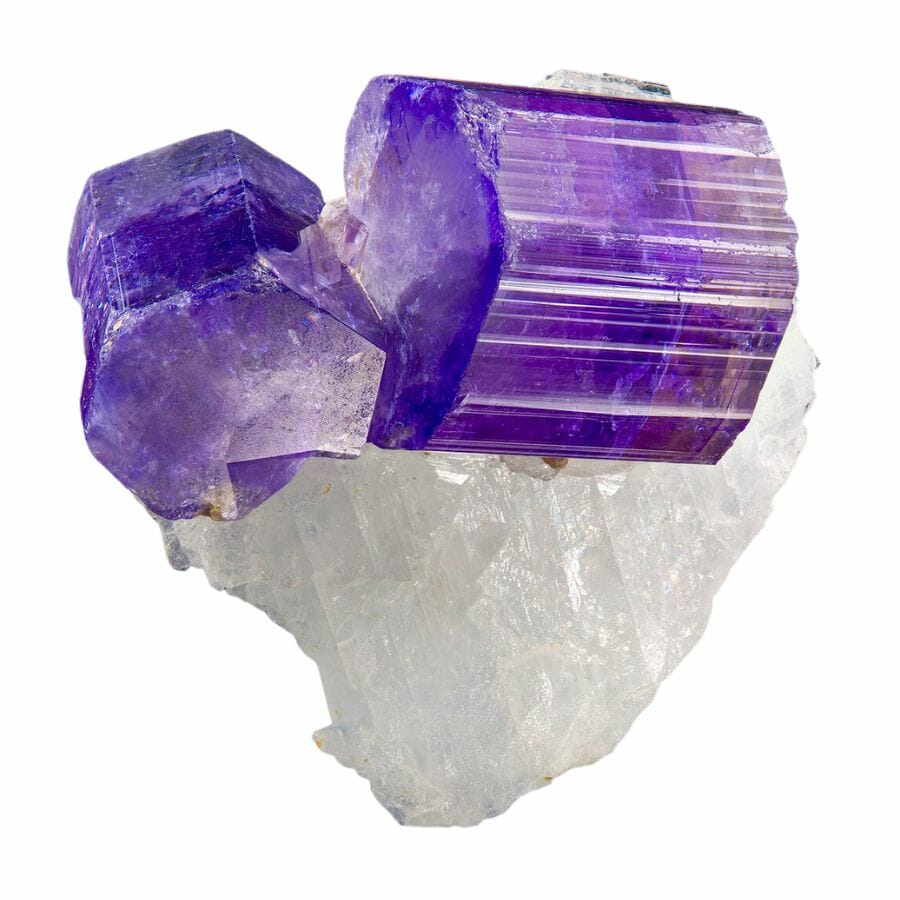
Fluorapatite is like the dazzling cousin in the apatite mineral family! This cool mineral is often a lovely blue or green color, but sometimes it can be clear or even a soft purple. Its name, fluorapatite, comes from the presence of fluorine in its structure.
The birth story of fluorapatite is a thrilling tale from deep within the Earth. Picture this: hot liquids filled with a bunch of elements swirling around, looking for pals to team up with. As they start to cool down, certain elements start pairing up.
In the case of fluorapatite, elements like calcium, phosphorus, oxygen, and fluorine come together in a special dance. And voila! Fluorapatite is born.
Its captivating colors make it one of the most sought-after crystals found in Massachusetts. When polished, it sparkles and shines, catching the eye of anyone nearby.
Fluorapatite also plays a helpful role in agriculture. It’s a source of phosphorus, which is super important for fertilizers. That means fluorapatite indirectly helps our plants grow big and strong.
Where you can find fluorapatite in Massachusetts
- Aggregate Industries Quarry, Ashland
- US Highway 3 / State route 62 interchange, Bedford
- Interstate 290/Interstate 495 interchange road cuts, Marlborough
The Gemstones Found in Massachusetts
Let’s shine a light on the mesmerizing gemstones that Massachusetts proudly calls its own. You can find a more in-depth look at the state’s gemstones in our comprehensive guides:
Garnet
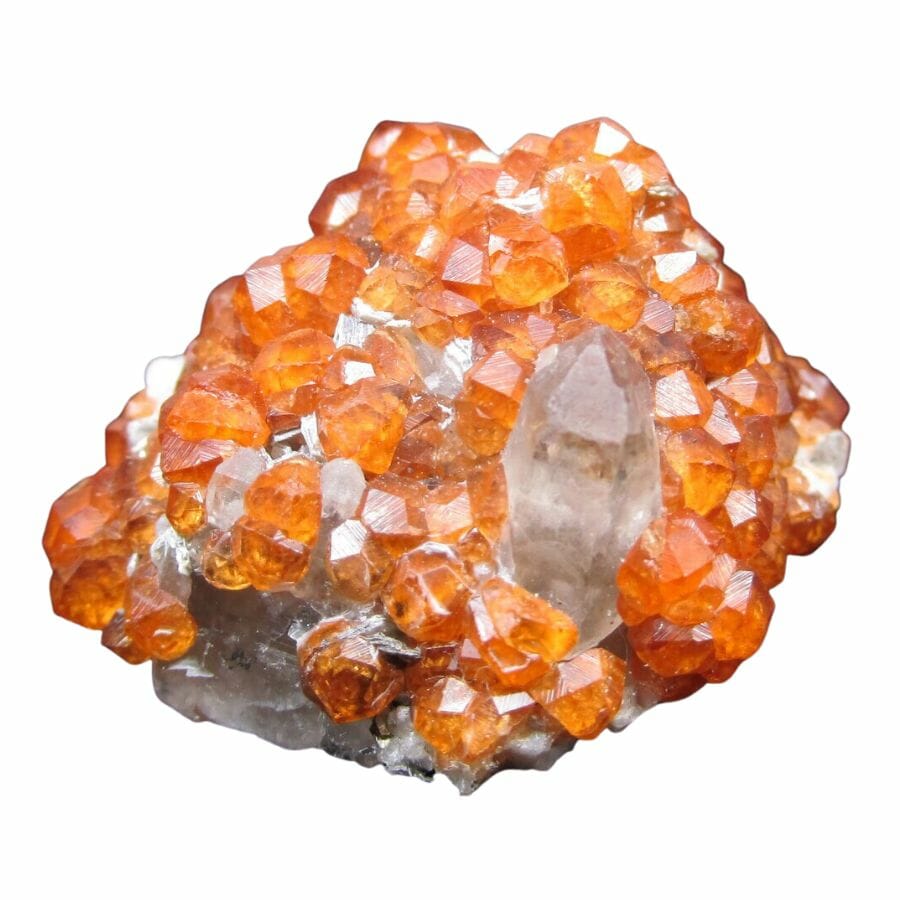
Garnet, with its deep red hues and sparkling facets, isn’t just found in jewelry stores; it’s also one of the most valuable rocks in Massachusetts!
When you think of garnet, you might picture a deep, glowing red gem. But guess what? Garnets can also be green, orange, pink, or even almost black. This variety of colors makes garnet truly special.
Garnet’s story starts deep inside our planet, where conditions are perfect for a mineral-making party. Here, different elements hang out in hot liquids. As these liquids cool down, the elements start to join together.
For garnet, this is when elements like iron, aluminum, and calcium decide to team up. As they bond, they form the beautiful and varied crystals we know as garnet.
With its vibrant colors, garnet is super popular in jewelry. Imagine a necklace or ring shining with a garnet’s deep glow.
Beyond jewelry, garnet has some practical uses too. Because it’s a tough and durable mineral, it can be used in things like sandpaper. Its rough, grainy texture makes it great for polishing and smoothing different types of surfaces.
Where you can find garnet in Massachusetts
- Russell Garnet Mine, Russell
- Wendell, Franklin County
- Betts Manganese Mines, Plainfield
Sodalite
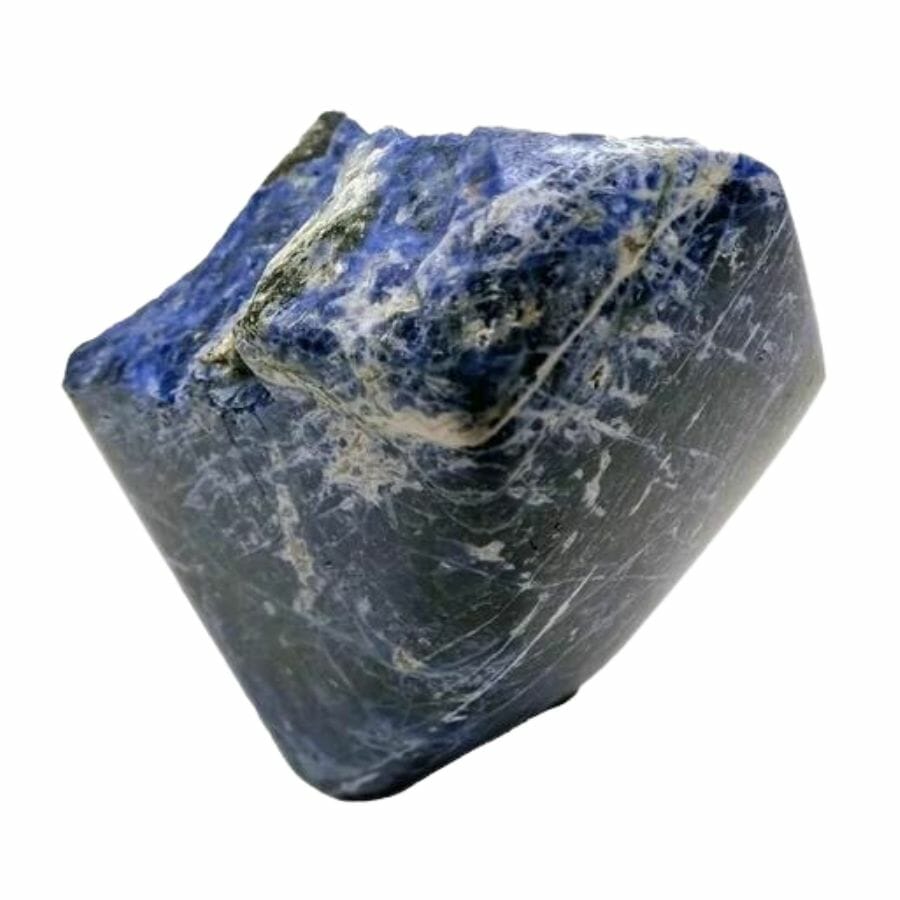
Sodalite is one of those minerals that’s just a joy to discover! Picture a deep blue sky dotted with fluffy white clouds. That’s what sodalite can look like, with its rich blue colors mixed with white streaks or patches
Deep inside the Earth, there are places where hot, molten rock called magma is cooling down. As it cools, various elements inside the magma start to team up and form different minerals.
For sodalite, certain elements like sodium, aluminum, and oxygen get together. As they bond and crystallize, they create the mesmerizing patterns and colors of sodalite.
Its striking blue color makes it a favorite for jewelry and decorative items. Think of necklaces, earrings, or even cool-looking sculptures made of sodalite!
Plus, some people believe that sodalite has calming properties, making it popular in spiritual and meditation circles.
But it’s not just about looks or beliefs. Sodalite has also been used in industry, especially in making glass products. Its unique chemical makeup helps to create some special types of glass.
Where you can find sodalite in Massachusetts
- Salem, Essex County
- Manchester-by-the-Sea, Essex County
- Beverly, Essex County
Aquamarine
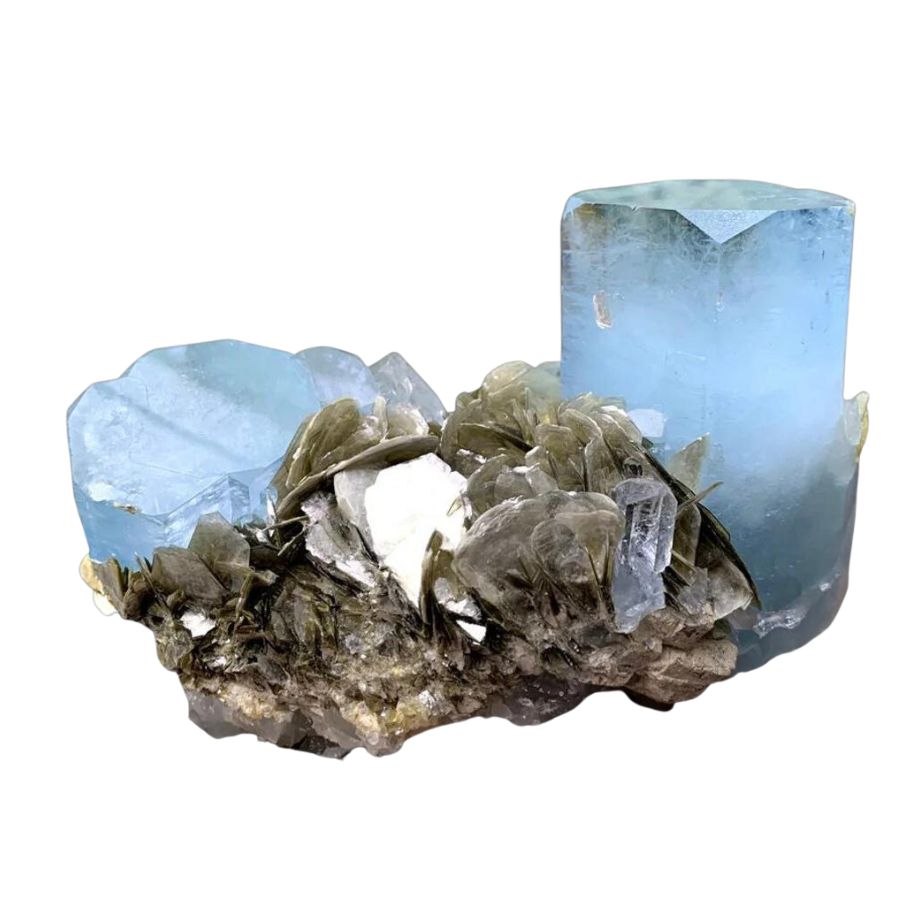
Aquamarine has a name that sounds just as beautiful as it looks! The name comes from two Latin words: “aqua” meaning water and “marine” meaning sea. It’s a name that paints a picture of clear, sparkling ocean waters.
That’s exactly the color of this stunning gemstone – a dreamy blue or blue-green, just like tropical seas.
Aquamarine starts its journey deep within the Earth. In places where magma is cooling down, elements like beryllium, aluminum, and silicon come together.
When these elements link up in the right way, they create the lovely crystal known as aquamarine.
It’s not very expensive, but the value of aquamarine goes beyond its price tag. Its soft blue color is simply breathtaking and is known to catch the eyes of gemstone enthusiasts all over the world
Jewelry makers adore aquamarine for its stunning appearance and often use it in rings, necklaces, and other pieces.
Aquamarine is also the birthstone for March, which means lots of people born in this month wear it in necklaces or rings.
And that’s not all! Throughout history, sailors would carry aquamarine as a lucky charm, hoping it would keep them safe on stormy seas.
Where you can find aquamarine in Massachusetts
- South Royalston beryl locality, Royalston
- Reynolds Mine (Beryl Hill Mine), Royalston
- Pearl Hill, Fitchburg
Rhodonite
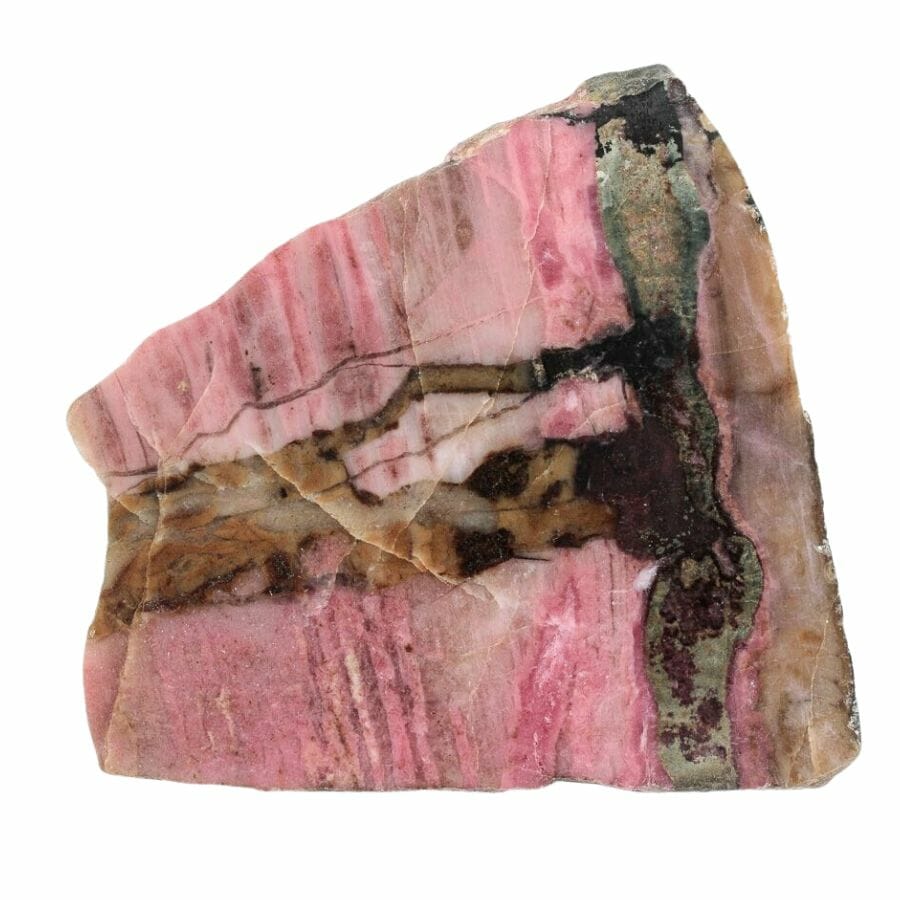
Rhodonite is a real showstopper in the world of minerals! Picture a stone with a rosy pink hue, sometimes mixed with black patterns or streaks. That’s rhodonite, standing out with its eye-catching color combo!
This mineral has a pretty neat origin story. Rhodonite is usually formed when magma cools down and hardens. During this cooling process, specific elements like manganese, oxygen, and silicon decide to come together.
As they bond and create crystals, they give birth to the beautiful pink and black patterns that are the trademark of rhodonite.
People adore rhodonite for several reasons. First, its vibrant pink hue with contrasting black streaks makes it a favorite for making jewelry, like necklaces, bracelets, and rings.
Apart from its beauty, rhodonite has another fun claim to fame. Many believe that this gem can help heal emotional wounds and encourage feelings of love.
In some places, rhodonite has also been used to make small decorative items and sculptures, showing off its rich colors and patterns.
Where you can find rhodonite in Massachusetts
- Betts Manganese Mines, Plainfield
- Forge Hill iron mines (Old Hawley iron mines), West Hawley
- Warwick, Franklin County
Rhodochrosite
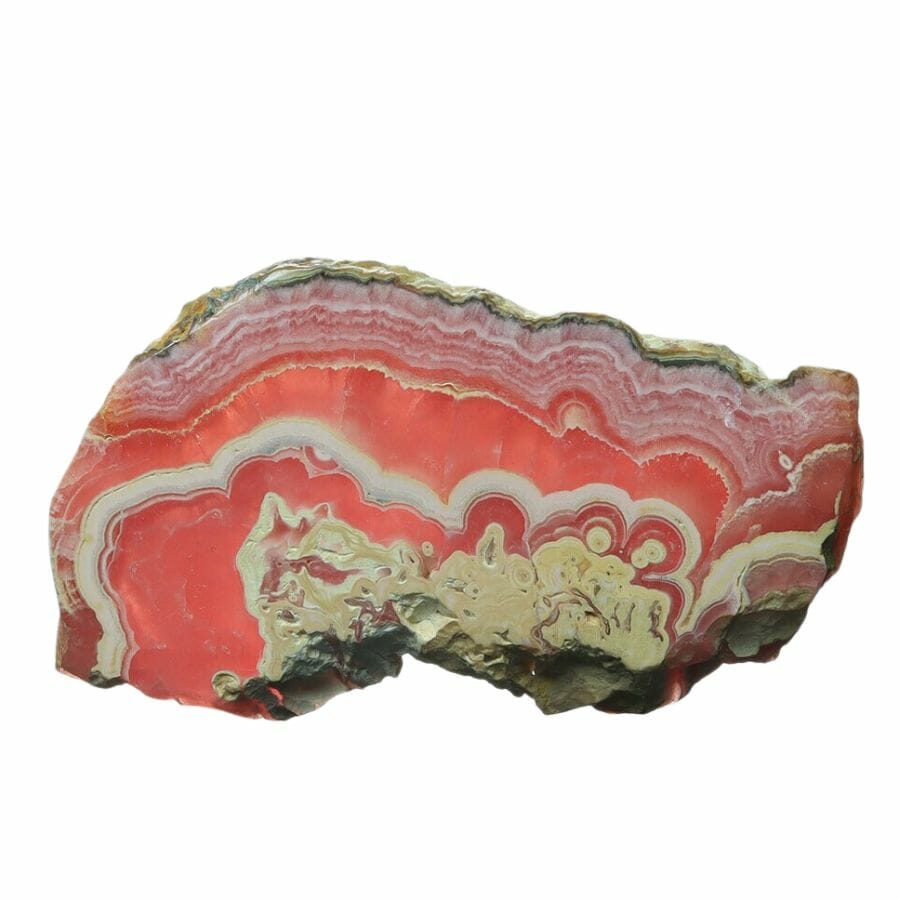
Rhodochrosite often forms in places where hot, watery solutions flow through cracks deep inside the Earth. These solutions carry various elements, including manganese, carbon, and oxygen.
As they mix and cool down, they create lovely rhodochrosite crystals.
Sometimes, rhodochrosite can also be found in caves as part of strange, flowing rock formations called stalactites and stalagmites.
Rhodochrosite’s unique color and pattern make it a favorite for jewelry. You’ll often see it turned into gorgeous earrings, pendants, and rings. And because each piece of rhodochrosite has its own special pattern, every jewelry item feels one-of-a-kind!
But it’s not just pretty to look at. Rhodochrosite is also studied by scientists for its unique chemical structure and properties. It’s a mineral that helps us learn more about how the Earth works.
Some people even believe rhodochrosite has the power to encourage love and compassion. Whether that’s true or not, one thing is sure: rhodochrosite is a gem that brings joy and wonder to those who discover it.
Where you can find rhodochrosite in Massachusetts
- Betts Manganese Mines, Plainfield
- Forge Hill iron mines (Old Hawley iron mines), West Hawley
- State Route 128 road cut/Cherry Hill area, Gloucester
Amazonite
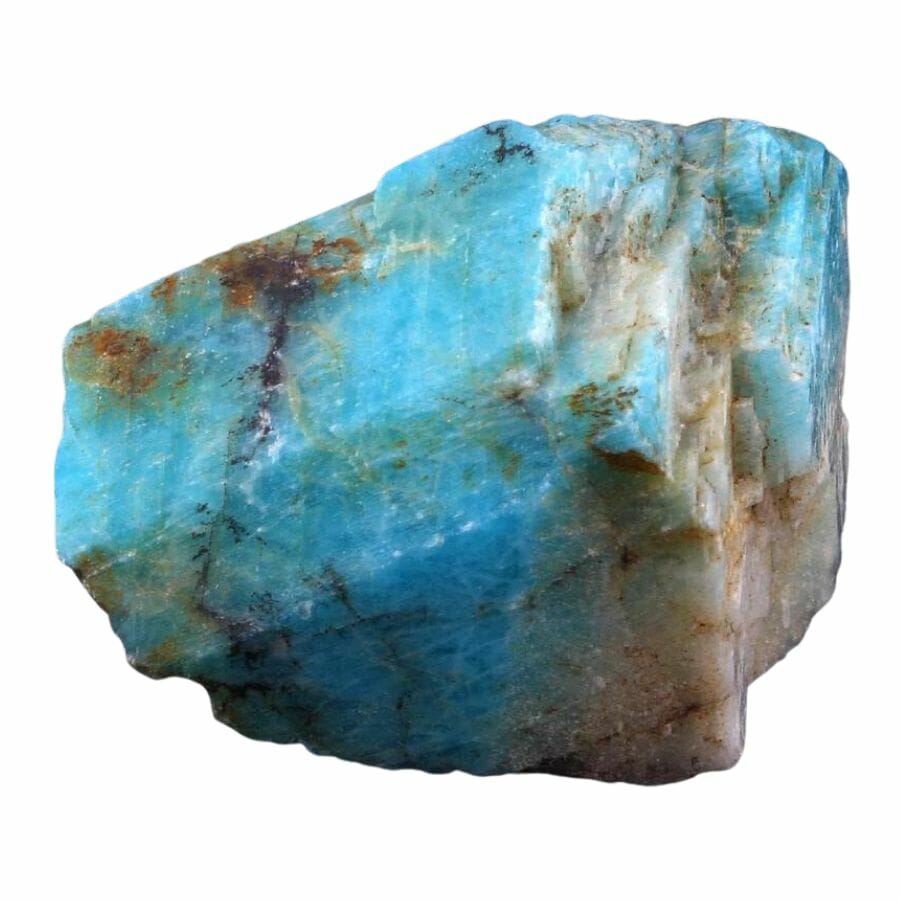
Picture a beautiful turquoise-green color, reminiscent of tropical seas, shimmering in rock form. That’s amazonite!
This vibrant mineral is a type of feldspar, one of the most common rock-forming minerals on our planet. Amazonite forms in pegmatites, which are large underground pockets of molten rock.
As this hot liquid rock cools and hardens, the right mix of elements, including potassium, aluminum, and oxygen, come together to create the lovely green crystals of amazonite.
Its stunning color is definitely a huge part of its appeal. Jewelers and crafters often choose amazonite for creating eye-catching jewelry pieces.
But its beauty isn’t the only thing that makes amazonite stand out among the different gemstones found in Massachusetts.
Historically, some cultures believed that amazonite had calming powers. People would keep a piece close by, thinking it could bring peace and balance to their lives.
And there’s more! Scientists and geologists are fascinated by amazonite. Studying this mineral gives them clues about the conditions deep inside the Earth when the rock was formed.
Where you can find amazonite in Massachusetts
- Walnut Hill Pegmatite prospect, Huntington (Norwich)
- Briscoe Hill, Beverly
- Blackburn Circle locality, Gloucester
Kyanite
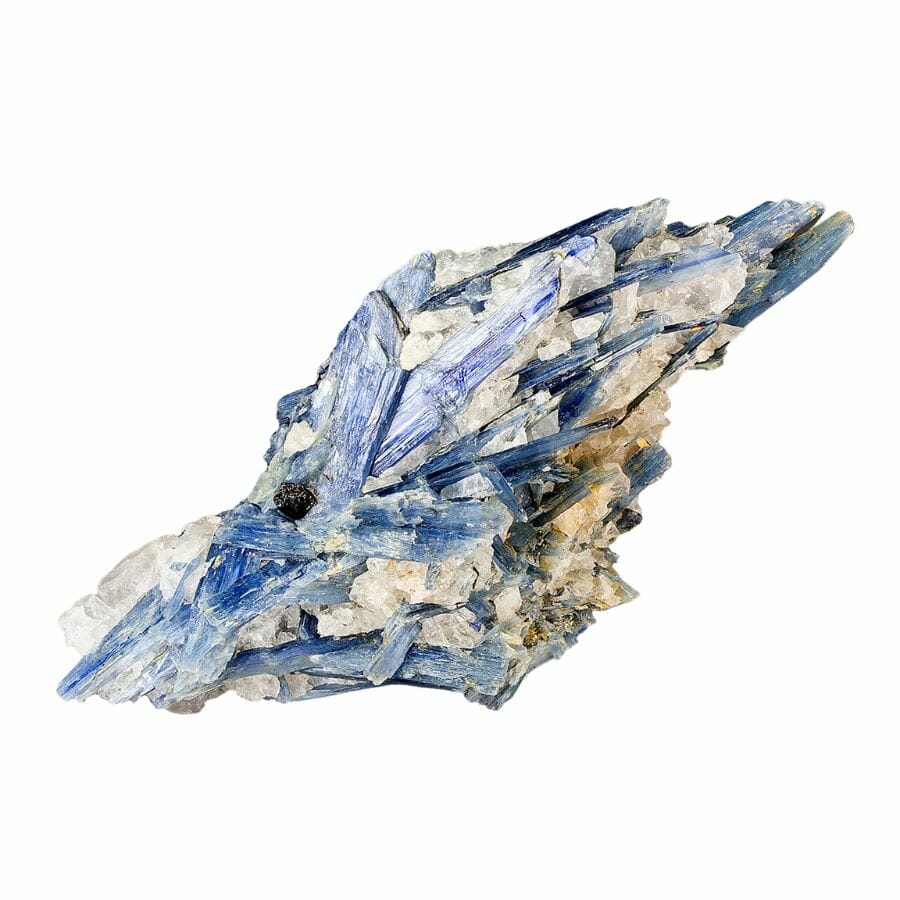
Kyanite is quite special in how it forms. This gem grows under the intense heat and pressure of metamorphic rocks. Imagine layers and layers of rock, all squished together so tightly that they begin to change and evolve.
As they transform, with the right mix of elements, kyanite crystals begin to take shape.
One of the super cool things about kyanite is its uniqueness in the world of minerals. It has a property called “anisotropy.”
In simpler terms, this means if you tried to scratch kyanite in one direction, it would be pretty tough. But if you tried in a different direction, it would be much easier.
Kyanite’s striking blue color is a showstopper for sure. It’s often used to create stunning rings, necklaces, and earrings. Artists are drawn to its varied shades of blue, which can range from pale to deep and vibrant.
This gem can also be used in industrial applications. Because it’s stable at high temperatures, it’s used in products that need to withstand a lot of heat, like ceramics and spark plugs.
Where you can find kyanite in Massachusetts
- Jungle Road area, Leominster
- PJ Keating Quarry (Lunenburg Quarry), Lunenburg
- Chesterfield Kyanite locality, Chesterfield
The Crystals Found in Massachusetts
Massachusetts is a crystal hunter’s dream. We can help you find the right locations to hunt for crystals in this state with the help of our guide:
Prehnite
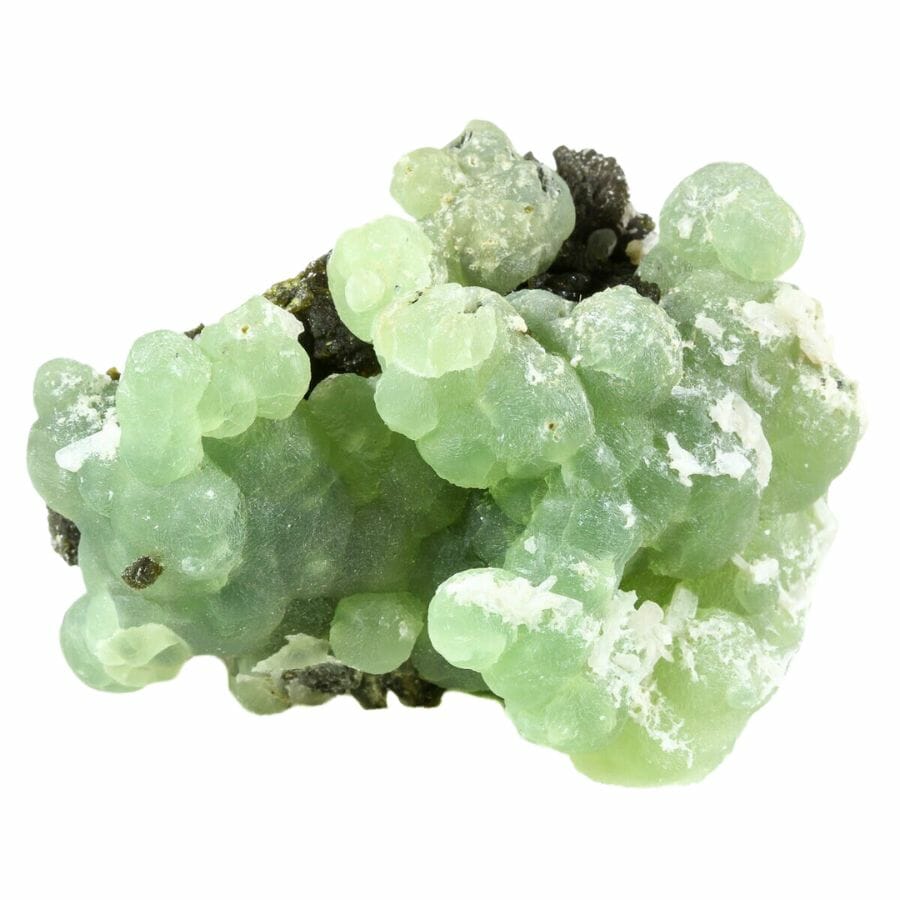
Massachusetts rock identification can lead you to discover some pretty awesome minerals, like prehnite.
Prehnite is a captivating mineral that captures the imagination of both rock lovers and the casual observer. It’s a gem that has a soft, dreamy green hue, sometimes almost transparent, other times a rich, velvety color.
At its core, prehnite is a calcium aluminum silicate mineral. It often forms in cavities in volcanic rocks, especially basalt.
But the cool part is that prehnite is known to form in a unique, bubbly, or botryoidal shape, making it look a bit like a bunch of tiny grapes made of crystal. It’s also found as stalactites in some places.
So, how does this beauty come into being? Prehnite forms in the voids and cracks of volcanic rocks, where hot mineral-rich fluids pass through. As these fluids cool down, prehnite starts to crystallize and grow.
Apart from its unique and pretty appearance, prehnite is often called the “Stone of Prophecy” in gem lore. Many believe it to be a stone of intuition, enhancing one’s ability to recognize truths and predict the future.
It’s also prized in jewelry for its soft and radiant color, creating pieces that exude calmness and elegance.
Additionally, prehnite has some practical uses. Due to its structure, it’s studied by scientists and geologists to understand the conditions under which certain rocks form.
Where you can find prehnite in Massachusetts
- Lane & Son traprock quarries (Lane’s Quarry), Westfield
- Hampden Quarry, West Springfield
- Mt. Tom Quarry, Mount Tom, Holyoke
Datolite
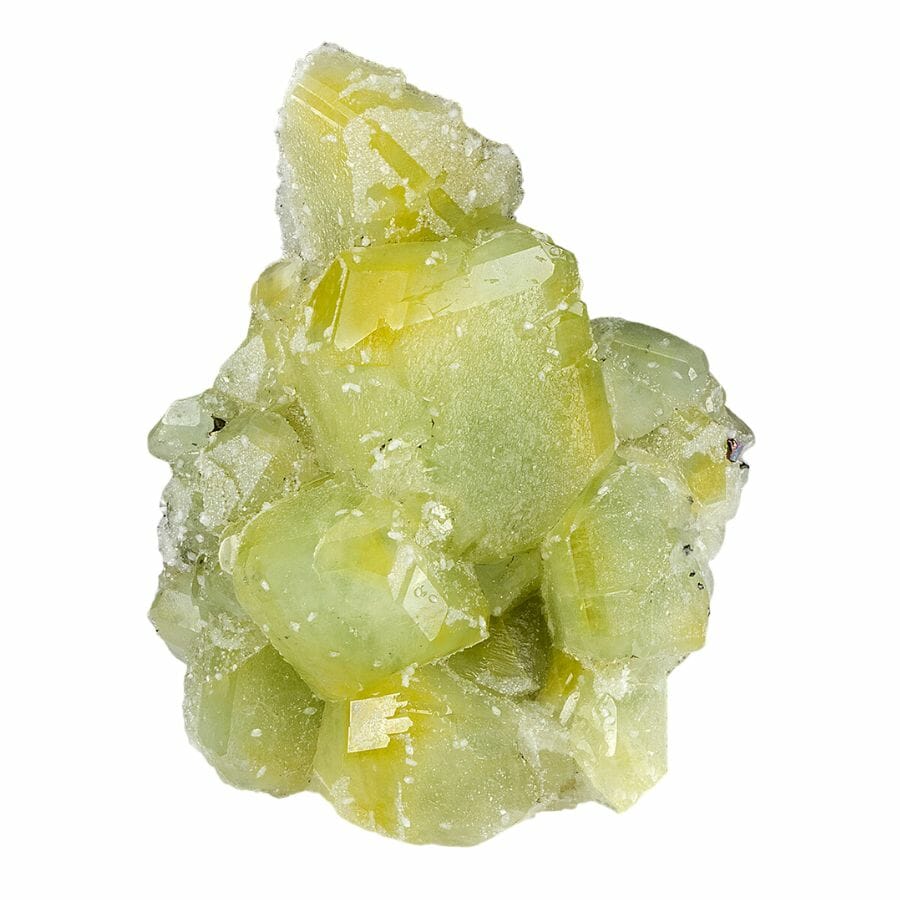
Datolite is a mineral that comes in an array of colors, from colorless to pale yellow, and sometimes even shades of green and pink. It has a sparkly, glass-like shine, which makes it a treat for the eyes.
This interesting mineral forms in cavities within basaltic volcanic rocks. Here’s the magic behind it: when hot water containing dissolved silica and boron moves through these rocks, as the water cools down, datolite begins to crystallize.
Over time, these small crystals can join to make bigger, beautiful specimens.
Datolite’s beauty is undeniable. Those who collect minerals often seek out datolite for its diverse range of colors and its lustrous sheen. Some pieces, especially those with a vibrant hue, can be cut and polished to make exquisite jewelry.
Besides its aesthetic appeal, datolite has scientific value. Geologists study it to gain insights into the environments and conditions where it forms. Its presence can provide clues about the history and changes the rock has undergone.
Where you can find datolite in Massachusetts
- Lane & Son traprock quarries (Lane’s Quarry), Westfield
- Hampden Quarry, West Springfield
- Cheapside Quarry, Deerfield
Lepidolite
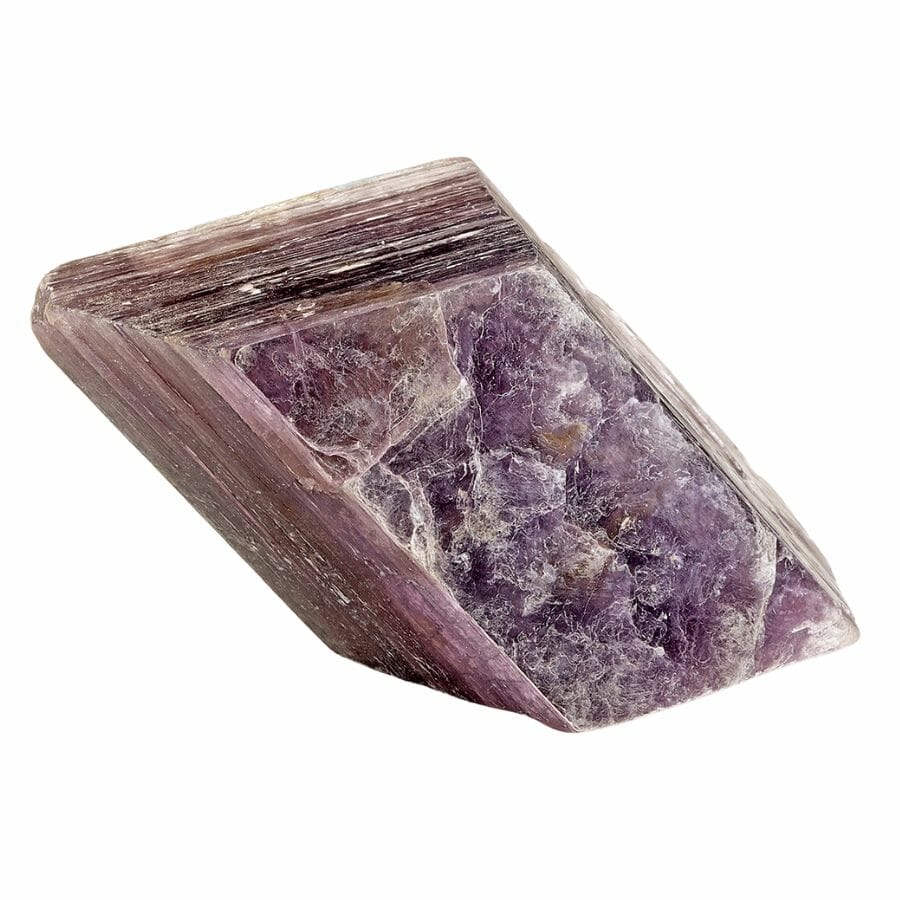
Lepidolite shimmers in colors like purple, rose, or even soft lilac. With these colors, it’s one of the more fascinating types of rocks found in Massachusetts.
The formation story of lepidolite is all about adventure. This mineral emerges from the cooling of molten rock, or magma. As the magma cools, different minerals begin to form, and in the presence of lithium-rich solutions, lepidolite takes shape.
It’s not a loner either; you’ll often find it hanging out with other minerals, such as tourmaline and quartz.
Aside from its obvious beauty, lepidolite has some cool uses too! One of its key components is lithium, which you might recognize as a name on batteries. Lithium is used in rechargeable batteries for things like our phones and laptops.
Lepidolite is one of the sources where we can extract this valuable element.
But it’s not just the practical uses that make lepidolite so special. Many people value it for its calming properties. Some believe that this gemstone can help bring peace and balance to one’s life.
Where you can find lepidolite in Massachusetts
- Clark Ledge pegmatite locality, Chesterfield
- Barrus Farm, Goshen
- Bolton Pegmatite float boulder occurrence, Bolton
Gypsum
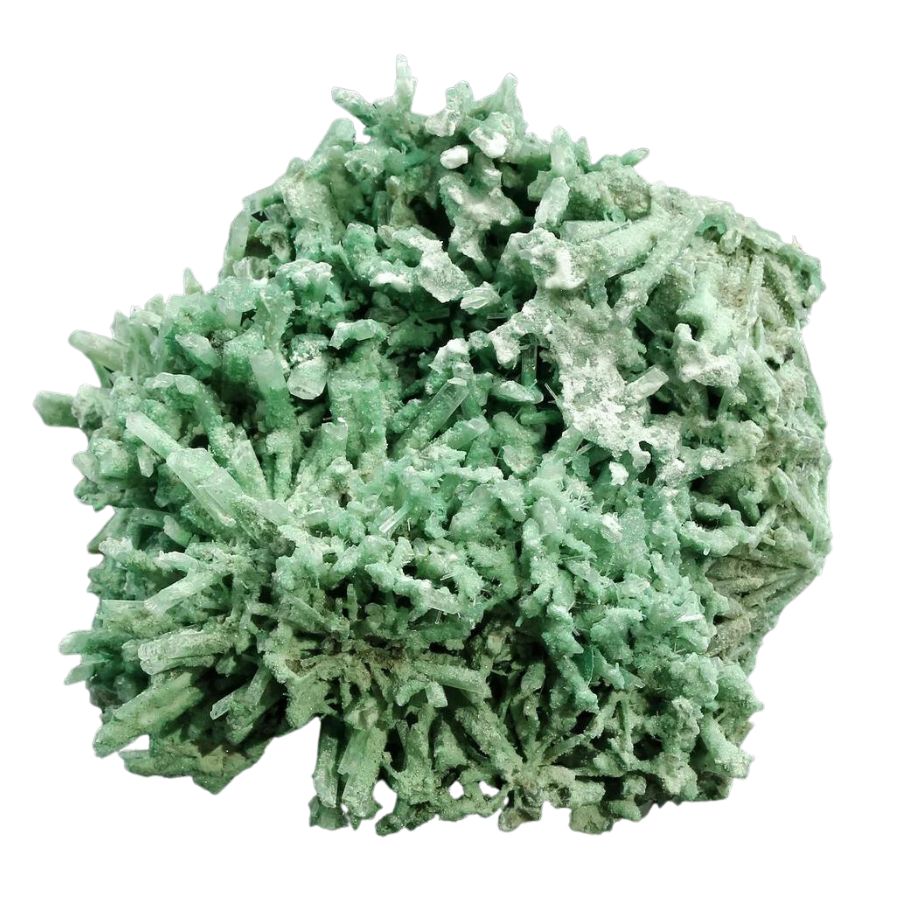
Gypsum is one of those fascinating minerals that you may have come across without even realizing it. Found in various forms, it’s a soft and often transparent mineral that really grabs attention.
First, let’s talk about how it’s formed. Gypsum is often born in dry, desert regions where salty lakes and seas have evaporated. As the water disappears, it leaves behind minerals, including gypsum.
Sometimes, gypsum can form from hot springs, or even in volcanic areas.
Gypsum is beautiful, especially when it forms into crystals like selenite. But its value goes way beyond its appearance. It’s also used in many everyday products that you’d never expect.
Drywall, the stuff used to make the walls in our houses, contains gypsum! The softness of gypsum makes it easy to work with, but when mixed with other materials, it can become strong and sturdy.
Gypsum also has a role in agriculture. Farmers use it to help break up compacted soil, allowing water and nutrients to reach plant roots more easily. This mineral not only beautifies our homes but also helps our food grow!
There’s also a cool scientific twist to gypsum. When it’s heated, the water trapped inside turns to steam, and the gypsum becomes a powder. This powder is the key ingredient in plaster.
Where you can find gypsum in Massachusetts
- Interstate 290/Interstate 495 interchange road cuts, Marlborough
- Milton, Norfolk County
- Delaney’s Quarry, Northampton
Babingtonite
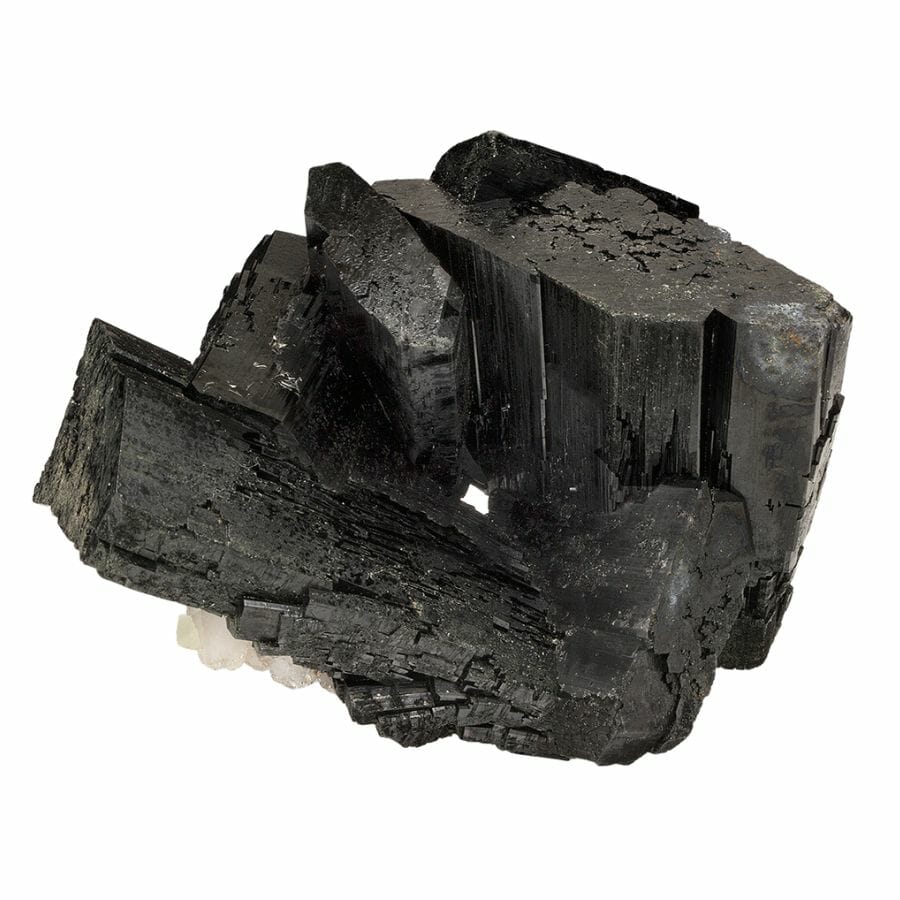
Babingtonite is one cool mineral that not everyone has heard of, but it sure has some interesting stories to tell! It’s usually dark green or black, and it forms really neat, sharp crystals.
When the light catches it just right, those crystals can have a shine that makes them look super special.
This mineral is formed in the pockets of certain volcanic rocks. These pockets, or “vugs” as we rock enthusiasts call them, are like little secret rooms in the rock where minerals like babingtonite can grow.
As hot fluids move through these pockets, babingtonite starts to form along with other minerals. It’s like there’s a tiny factory inside the rock making shiny crystals!
Babingtonite’s interesting appearance makes it a favorite among mineral collectors. It’s also pretty rare. When you find babingtonite, you know you’ve got something special in your hands.
But babingtonite deserves a special shout-out when we talk about crystals found in Massachusetts. That’s because it’s the official state mineral!
This humble mineral got such a big honor because it’s not just beautiful, but also represents a part of the state’s natural history.
Where you can find babingtonite in Massachusetts
- Cheapside Quarry, Deerfield
- Athol babingtonite locality, Athol
- Quabbin Aqueduct shaft No. 10 locality, Hardwick
Diopside
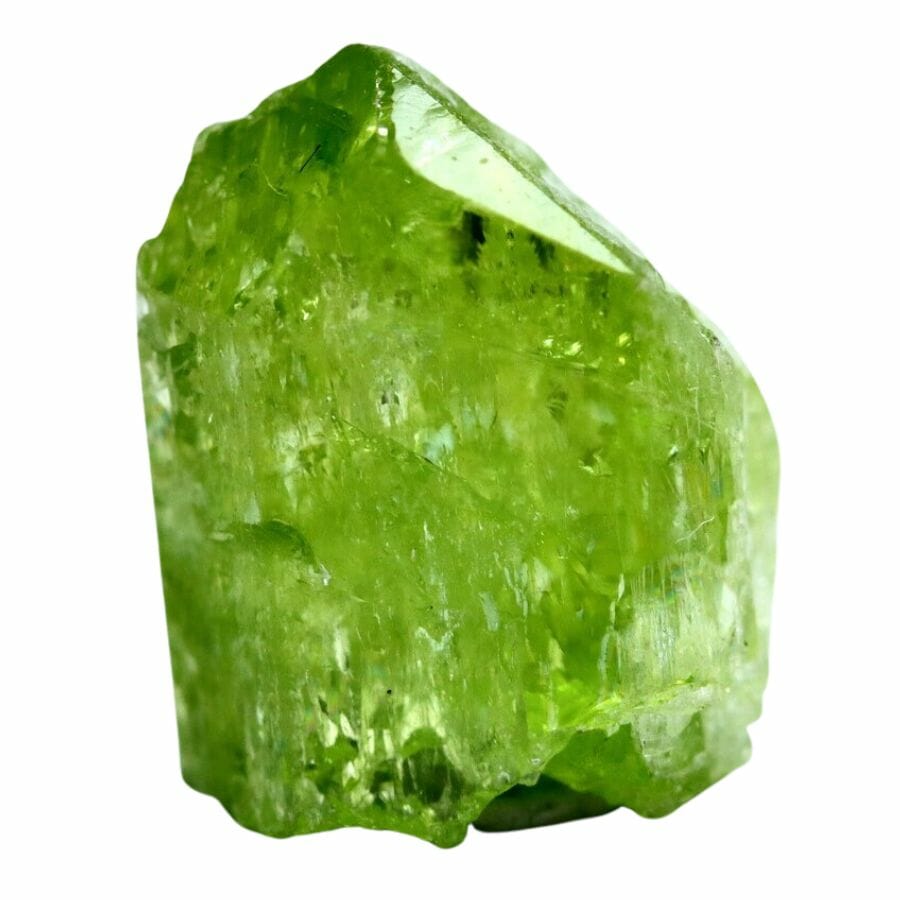
Diopside’s crystals range from light green to almost black. Sometimes, you might even spot the gemmy version of diopside, which is a bright, shiny green and looks like it jumped straight out of a fairy tale.
Deep down beneath our feet, there’s a lot of heat and pressure. When certain types of rocks get exposed to this underground “cooking” process, diopside starts to form.
It loves to grow in places like marble and metamorphic rocks, which are rocks that have been transformed by heat and pressure. Think of it lin ke a cake baking in an oven; the ingredients go in, but something totally different and delicious comes out.
Diopside’s variety of colors is a big hit. That bright green version of diopside, often called “chrome diopside,” is especially popular in jewelry. It sparkles and catches the light, making it a favorite for earrings, necklaces, and rings.
But there’s more to diopside than just its beauty. It’s also used by scientists as a clue to figure out how certain rocks formed and to understand the history of our planet.
Where you can find diopside in Massachusetts
- Marlborough Junction locality, Marlborough
- Bolton Lime Quarries, Bolton
- PJ Keating Quarry, Lunenburg
Zoisite
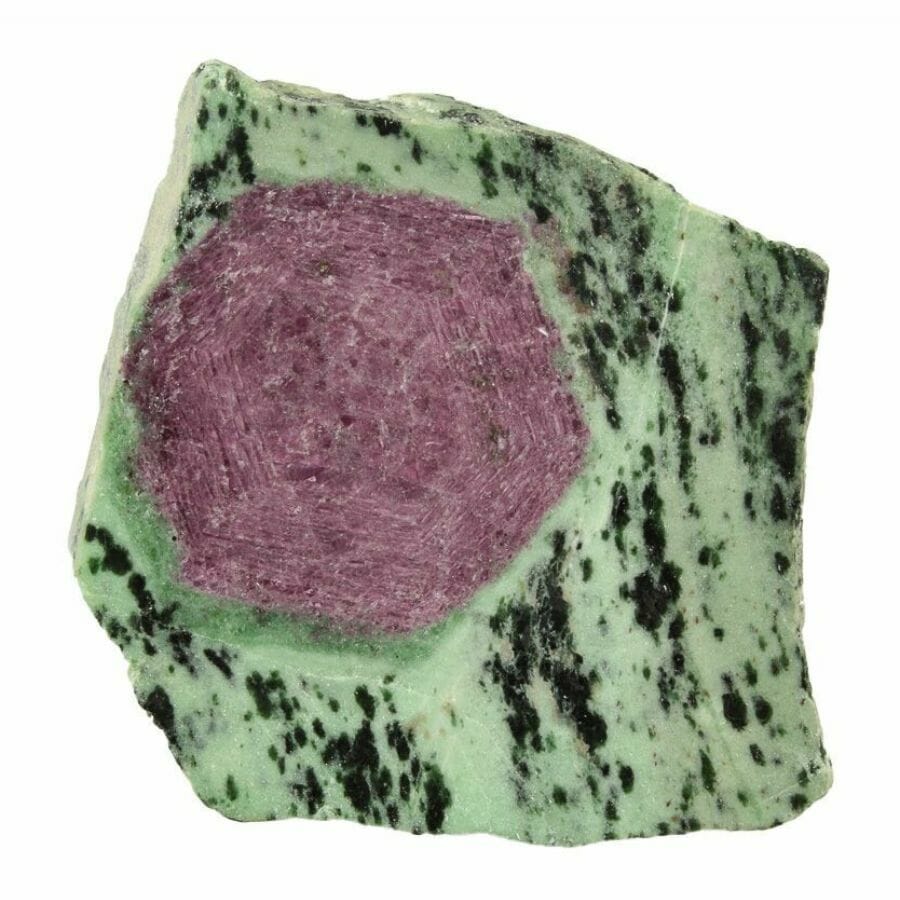
Among the rocks and minerals found in Massachusetts, ziosite stands out as a unique and colorful mineral. It comes in different vibrant colors, from pink to gray, green to blue, and sometimes even multiple colors in a single stone!
But what’s even more fascinating is how it’s made. Deep under the Earth’s surface, when limestone gets cooked up with a pinch of heat and a dash of pressure, zoisite starts to form.
Sometimes, zoisite teams up with another mineral called ruby. When this happens, we get an amazing rock called “ruby in zoisite.” Imagine a stunning red ruby embedded in a sea of green zoisite. This colorful blend is amazing to look at!
Ziosite’s variety of colors makes it super popular for jewelry. Those pretty shades can be turned into necklaces, rings, and more. Plus, some people believe that ziosite has healing powers, like helping people feel more positive and energetic.
Whether you’re into its beauty or the stories behind it, there’s no doubt that zoisite is a rock star in the world of minerals!
Where you can find zoisite in Massachusetts
- Walnut Hill Pegmatite prospect, Huntington (Norwich)
- Conway, Franklin County
- Milford, Worcester County
The Most Valuable Rocks and Minerals in Massachusetts
Massachusetts is like a treasure chest, brimming with some of the most prized rocks and minerals on Earth. From sparkling gems to rare stones, let’s dive into the fascinating world of Massachusetts’s underground riches!
Roxbury puddingstone
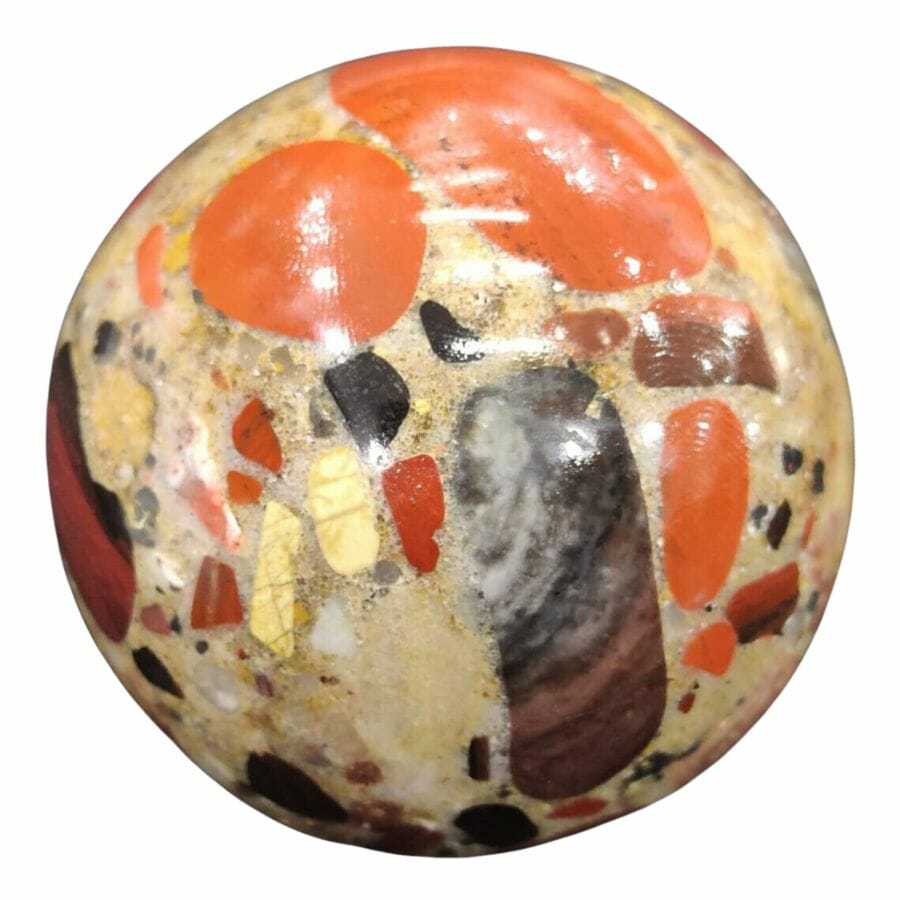
Officially known as the state rock of Massachusetts, Roxbury puddingstone isn’t just any ordinary rock. It’s a type of conglomerate, which means it’s made up of a mix of different rock fragments all squeezed together.
Now, picture a delicious fruitcake. Puddingstone is kind of the geological version of that.
It has a rich, dark brown or reddish-brown matrix (that’s the cake part!) filled with pebble to cobble-sized chunks of various rocks, mainly round quartz pebbles (those are the fruits!).
Roxbury puddingstone started its life around 600 million years ago. Over time, ancient rivers transported pebbles and cobbles, depositing them in layers.
As more and more layers built up, pressure from above squished them all together, and with a little help from minerals seeping through, they became the solid Roxbury puddingstone.
This rock isn’t just neat to look at; it’s also valued for its historical and cultural significance, especially in Boston. The puddingstone can be seen in many buildings and landmarks around the city.
Plus, geologists and rock collectors love it because it tells a unique story about Earth’s ancient past. So, next time you’re in Massachusetts, keep an eye out for this fantastic rock; it’s a piece of history sitting right under our feet!
Where you can find Roxbury puddingstone in Massachusetts
- Puddingstone locality, Roxbury, Boston
Opal
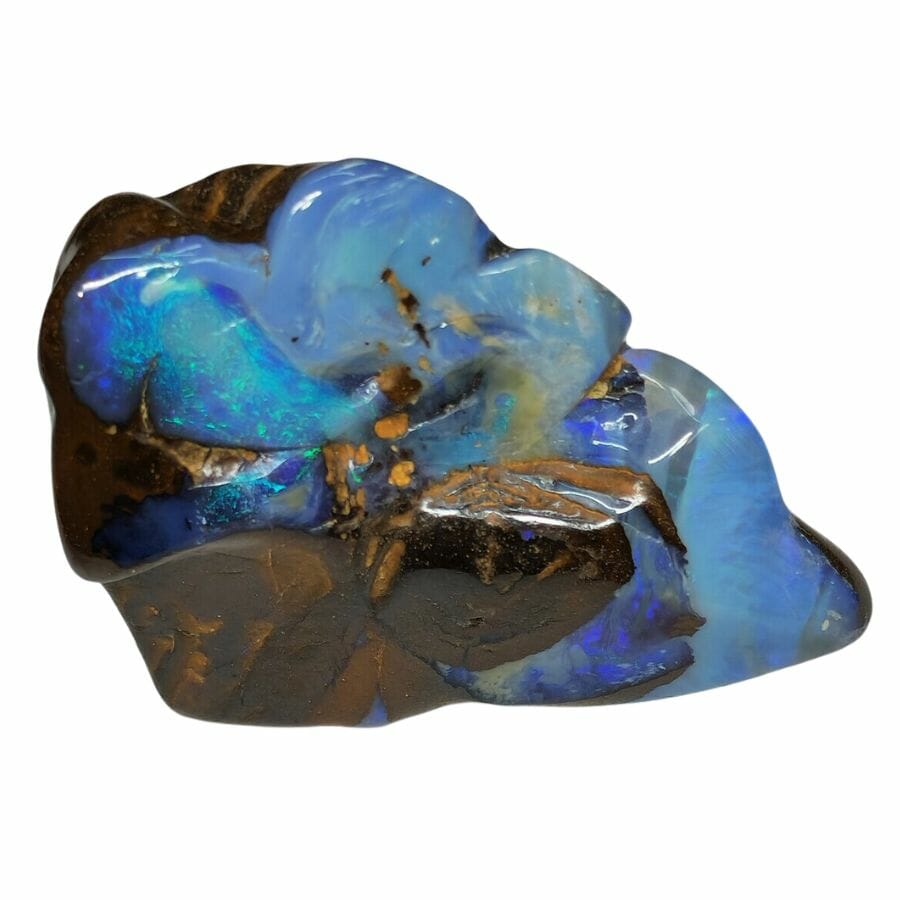
Opals are like rainbows trapped inside a rock! If you’ve ever held an opal up to the light, you’d see a dance of fiery colors ranging from blues and greens to fiery reds and oranges.
It’s a sight to behold and easily makes opal one of the most magical and mesmerizing gemstones out there.
Opals form when water, rich in silica, seeps into the ground and fills cracks or spaces in rocks. Over time, as the water evaporates, it leaves behind tiny silica spheres.
These spheres pile up in layers, and like magic, they create the shimmering colors of the opal.
This play of color is what makes each piece of opal unique.
Apart from its sheer beauty, many cultures believe that opal brings good luck. For centuries, people have used opals in jewelry, from rings to necklaces, to show off their dazzling colors.
They’re often given as gifts to celebrate 14th wedding anniversaries, making them one of the most valuable rocks in Massachusetts.
Opals also come in many varieties. There’s black opal, which has a dark background and is super rare, and there’s white opal, which is lighter. There’s even boulder opal, which has thin veins of color running through the stone.
Where you can find opal in Massachusetts
- Route 13 area, Lunenburg
- Rollstone Hill Quarries, Fitchburg
- PJ Keating Quarry, Dracut
Zircon
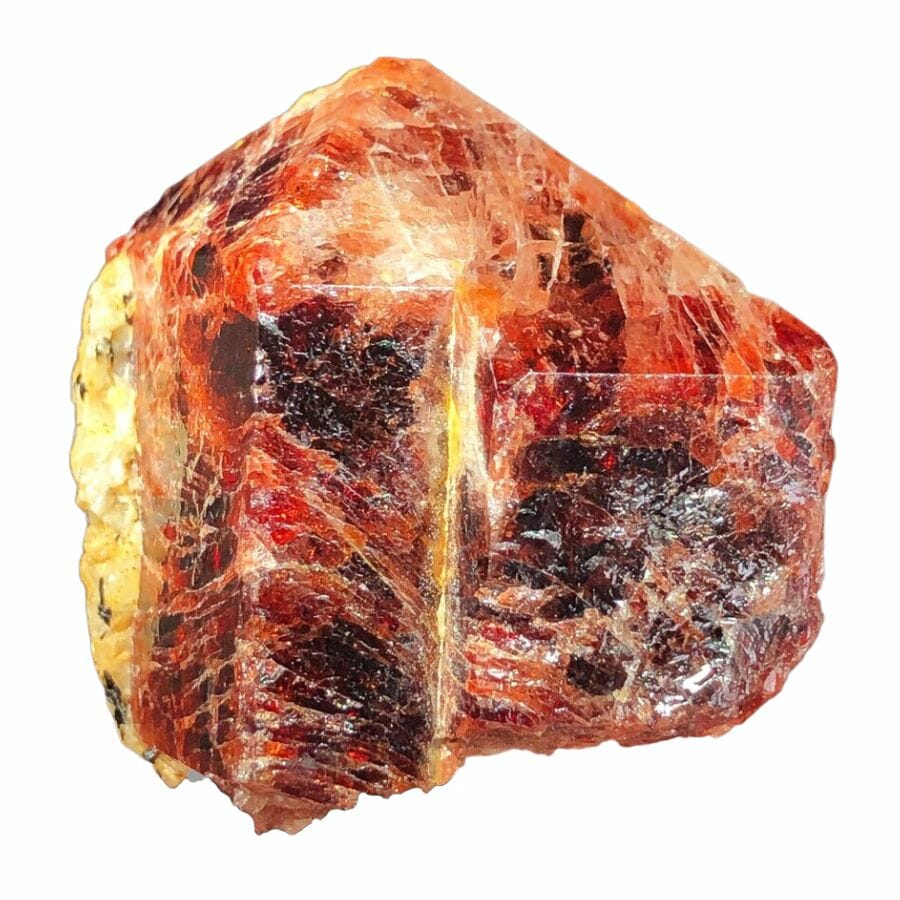
Zircon is an amazing gemstone that has a sparkle similar to diamonds. But there’s more to zircon than just its shimmer! It’s one of the oldest minerals on Earth, and it’s been around for billions of years!
This ancient gem forms from magma. When this magma starts to cool down, zircon crystals begin to grow. Over time, these crystals get pushed closer to the Earth’s surface because of natural movements like earthquakes.
Eventually, zircon crystals can be found in rocks or even in the sand at beaches.
Zircon comes in a rainbow of hues, from clear to deep reds, sunny yellows, and even cool blues. The different colors happen because of tiny amounts of other minerals that sneak into the zircon as it forms.
Its dazzling brilliance makes it a favorite for jewelry. Plus, since it’s been around for so long, scientists sometimes use zircon to learn about Earth’s history. By studying zircon, they can figure out what our planet was like billions of years ago.
Where you can find zircon in Massachusetts
- Railcut Hill, Gloucester
- Rockport, Essex County
- Chelmsford Lime Quarries, Chelmsford
Spinel
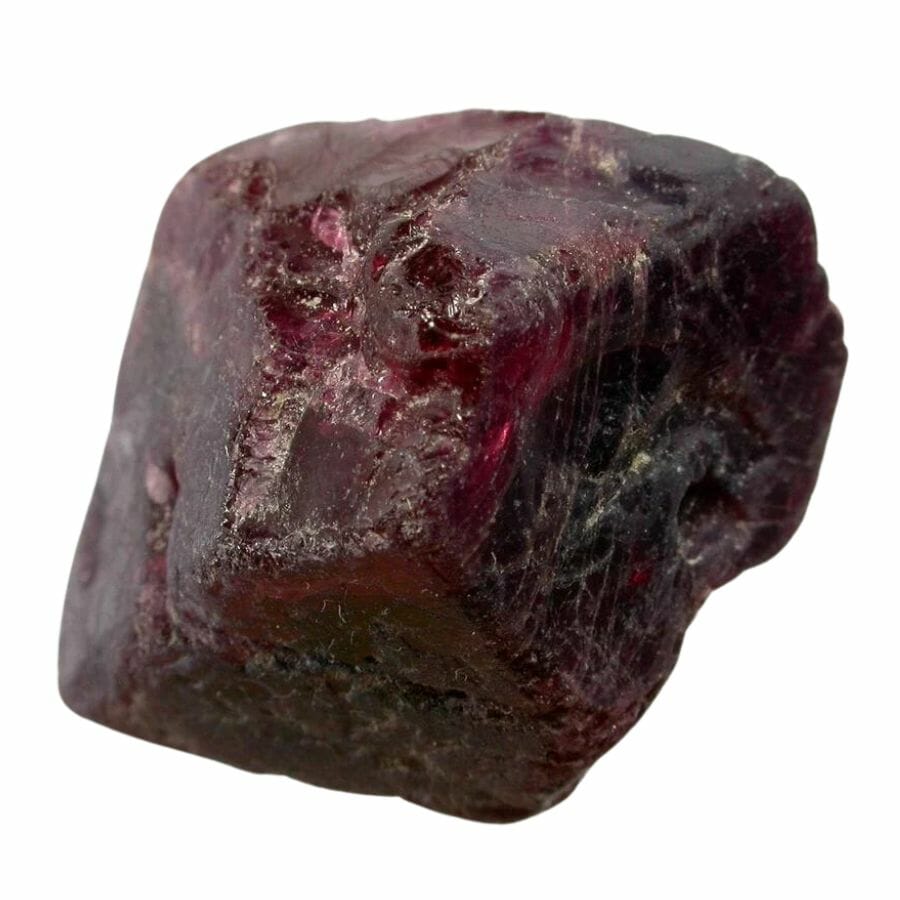
If you’ve ever seen a gem that shines in vibrant reds, pinks, blues, or even purples, you might have laid eyes on spinel.
Spinel is born deep within the Earth’s crust, where heat and pressure are super high. Here, limestone gets cozy with magma.
When the two meet, spinel starts to form. It’s like baking a cake, but instead of flour and eggs, you’ve got magma and limestone.
And when the “oven” cools down, we get these shiny spinel crystals!
Now, you might be wondering why spinel isn’t as famous as rubies or sapphires. Well, for a long time, people actually got them mixed up! Some famous “rubies” in crown jewels are actually red spinel.
That just goes to show how beautiful spinel really is.
Other than its appearance, spinel is super durable, making it great for jewelry. It also won’t scratch easily, so you won’t have to worry too much about wearing it.
Where you can find spinel in Massachusetts
- Chester Emery Mines slag locality
- Bolton Lime Quarries, Bolton
- Chelmsford Lime Quarries, Chelmsford
How to Identify The Rocks and Minerals Found in Massachusetts
Let’s jump right into the fascinating ways we can identify those mysterious minerals, rocks, and gems you might stumble upon!
With so many tools and methods at your disposal, identifying various rocks and minerals can be easier than you might expect.
Test the mineral’s hardness

The hardness of a mineral tells us how strong or soft it is.There’s this cool tool called the Mohs Scale that helps us figure it out.
Picture the Mohs Scale as a ladder with ten steps. On the very first step, you have talc. It’s super soft and has a hardness score of 1. You could even scratch it with your fingernail!
But on the top step, the tenth one, there’s the diamond. It’s one of the hardest known materials on Earth and has a hardness score of 10.
Now, let’s play detective with our minerals. If you’ve got a mineral that can leave a mark on a copper penny but doesn’t do anything to glass, it’s hanging out in the middle of our Moh Scale ladder.
So, the next time you come across a shiny stone or a cool-looking rock, think about where it might fit on our hardness ladder. When exploring the types of rocks found in Massachusetts, this scale can help you figure out what you’ve stumbled upon.
Check the mineral’s streak
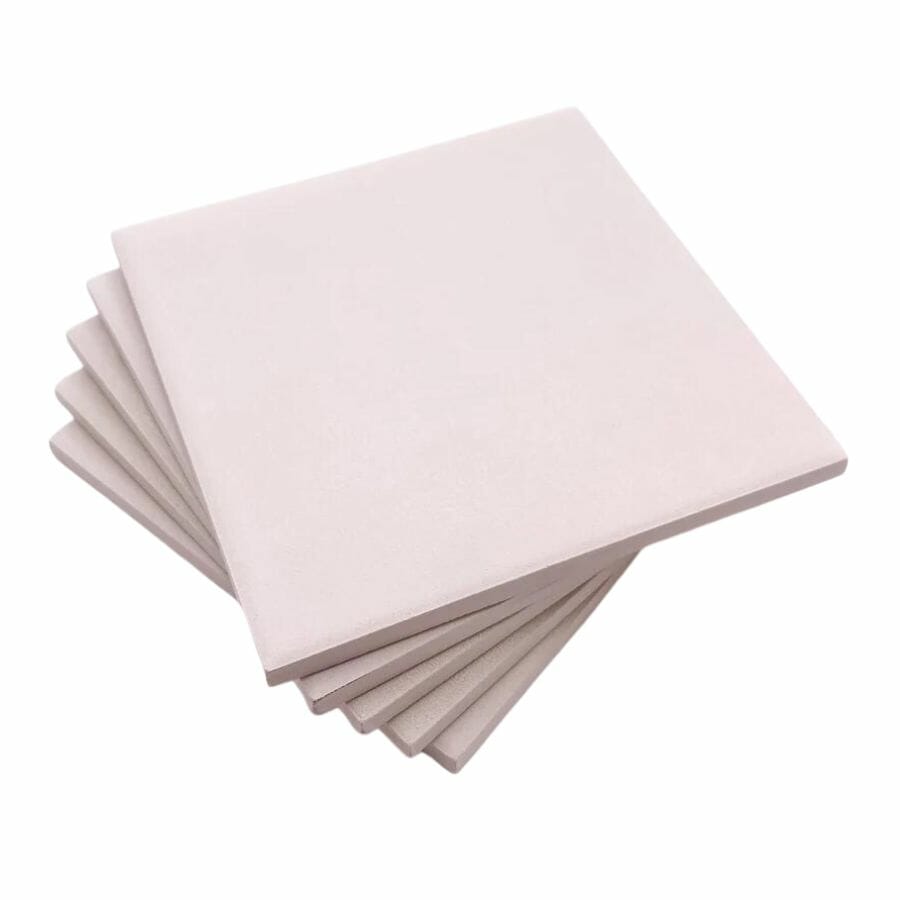
The streak test is one of the coolest tools in your detective kit! When a rock or mineral is rubbed against a rough surface, like the unglazed bottom of a porcelain tile, it leaves behind a powdery line.
This line is its “streak,” and it can be a totally different color from the rock or mineral itself.
Hematite is a great example. It might look silver or black, but it always leaves a rust-colored streak. So even if the mineral changes color on the outside, its streak color usually stays the same. It’s like the mineral’s fingerprint!
Just remember that minerals softer than porcelain, which has a hardness score of about 6.5, are the ones that will leave a streak. Minerals that are harder than porcelain will leave a colorless streak.
Determine its luster
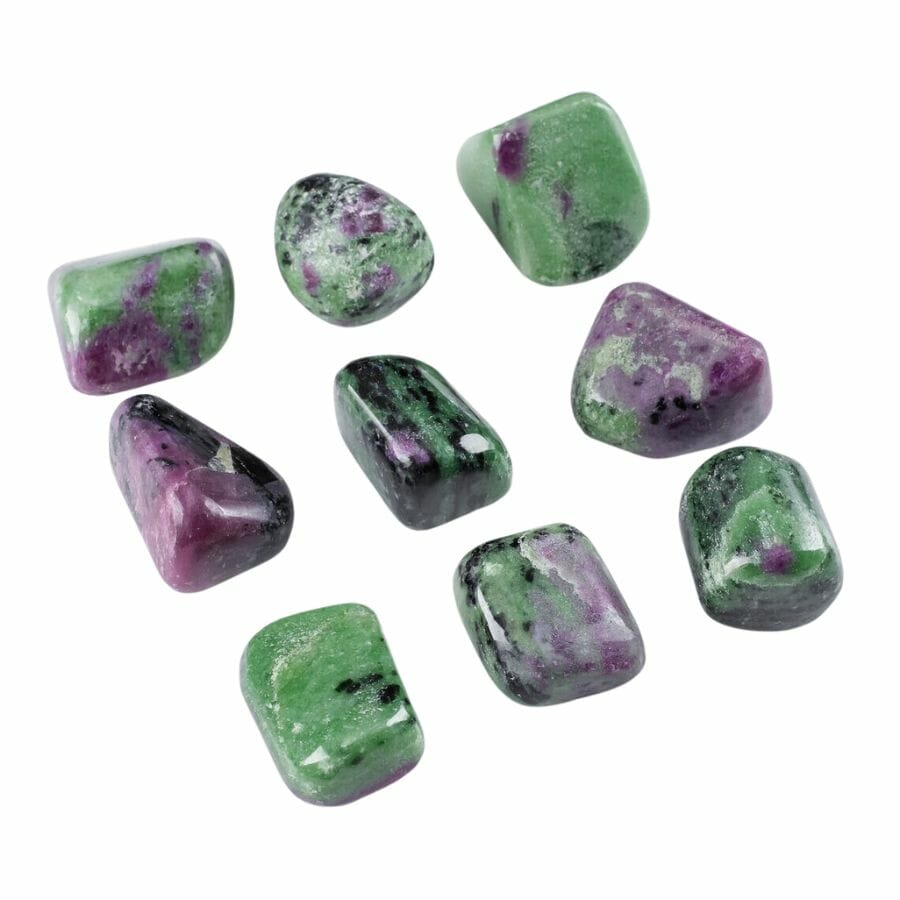
Luster refers to the sparkle or shine that comes off of minerals when light hits them. Just like people have different personalities, minerals have different lusters!
When a mineral shines like metal, as if it’s a tiny piece of gold or silver, it’s said to have a “metallic” luster. Imagine finding a treasure chest, and the coins inside have this kind of shine.
But not all minerals like to shine bright like metals. Some have a soft, gentle glow, reminding us of the inside of a seashell. This dreamy shine is called a “pearly” luster. It’s like the mineral is giving you a calm, soothing vibe.
Apart from metallic and pearly, there are more types of luster out there. Some minerals might look greasy, like they have a thin layer of oil on them. Others might appear glassy, like a clear windowpane.
Identify the cleavage or fracture
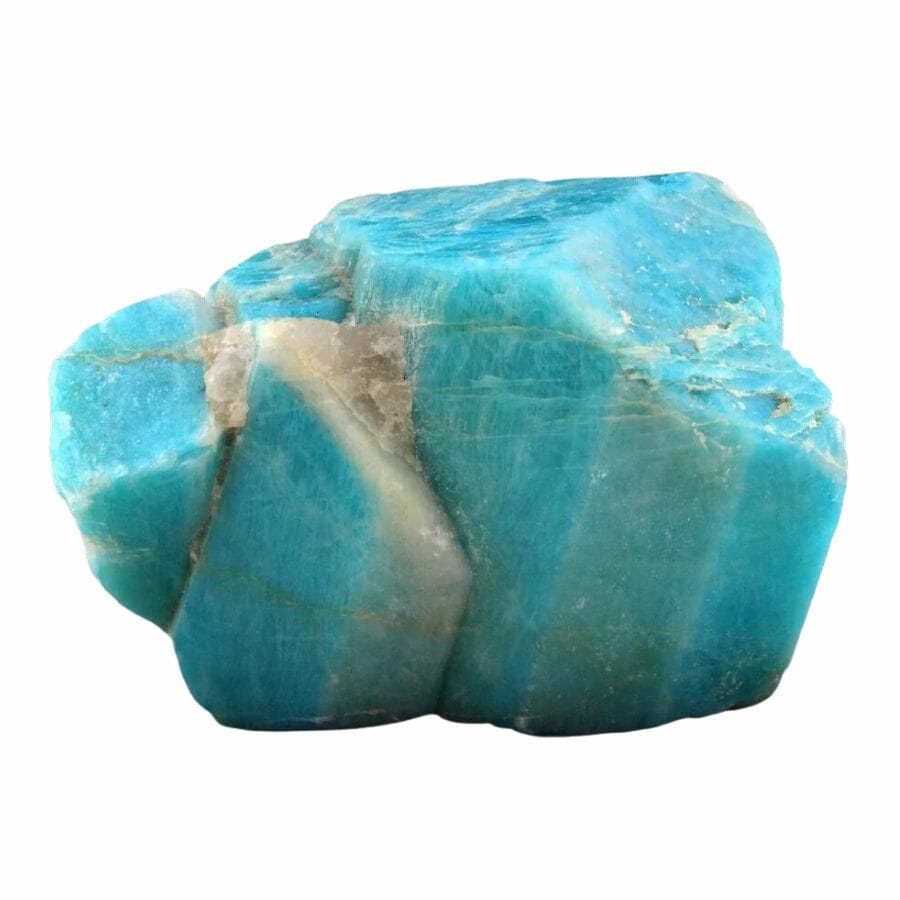
Now, when we talk about cleavage and fracture, we’re looking at how minerals and rocks break apart. It’s like each mineral has its own style of breaking up!
First up, we’ve got cleavage. It’s when minerals decide to split along nice and neat flat surfaces.
Mica is the superstar here. You’ve probably seen it; it likes to break into super thin, almost see-through sheets. It’s like flipping through the pages of a very delicate book.
On the flip side, there’s fracture. This is when minerals don’t have a plan and just break wherever they feel like it. This results in all sorts of uneven, rough, and jagged edges.
Obsidian is our rock star in this category. When it breaks, it looks a lot like shattered glass – sharp and unpredictable!
Determine the crystal structure and habit
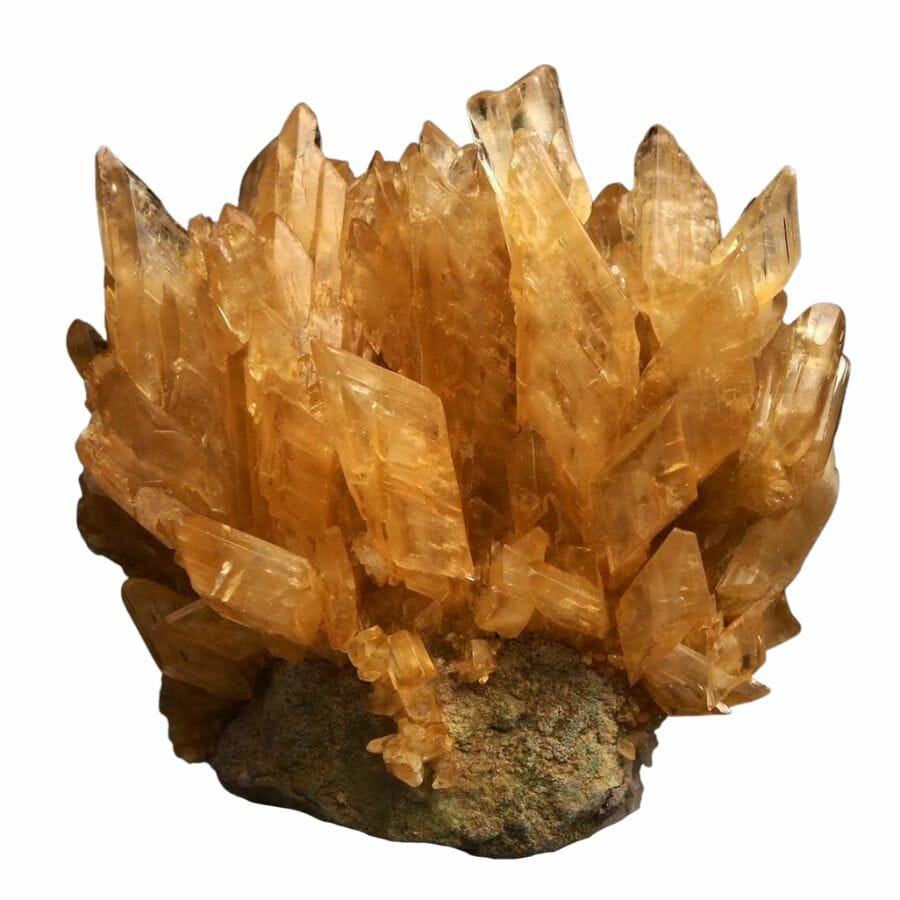
When diving into Massachusetts rock identification, a cool place to start is by looking at a rock’s crystal structure and habit.
Crystal structure is like the blueprint of a mineral. It’s the pattern of how the tiniest bits, called atoms, are arranged inside. There are several shapes these structures can have, like cubes, hexagons, and even more complex forms.
Now, crystal habit is the way these structures show up on the outside. It’s like how someone might have curly hair or wear glasses; it’s the appearance!
Some minerals grow in neat, cool shapes like pyramids or long columns, while others might form flat plates or rounded blobs.
By checking out a mineral’s shape and the way its crystals are put together, you can learn a lot about what kind of mineral it is.
For example, quartz often forms pointy, six-sided columns, while halite (which is actually rock salt) forms in cubes. It’s like each mineral has its own signature look, making them easier to identify.

